All Aboard the Board Game Train
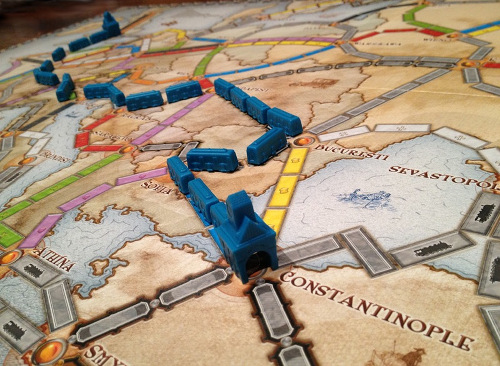
If every addiction has a gateway drug, for board games, Ticket to Ride is that drug. Easy to learn, fun to play, difficult to master. It was my entry to serious gaming, and it is still in heavy rotation on our game table after years of playing. If I had to chose a favourite game, Ticket to Ride would be it.
Ticket to Ride has all the virtues of a virtuous game: it sets up quickly, it proceeds quickly, everyone's in it until the end, and victory is uncertain until the final tally. Some people think this game is too straightforward, even simple; that it's not suited for the the sophisticated, cut-throat gamer. Those people probably think badminton is a gentle game too.
It's true the game mechanic is simple. (Again, a virtue in my opinion.) You collect sets of Train cards and redeem them to build routes that connect the cities indicated by Tickets you hold in your hand. The sophistication of the game lies, as it does with all classic games, in the playing. This may be because the strategies required to win Ticket to Ride are contradictory. You must be reserved and you must be agressive.
The game favours the bold. Players who draw more Tickets risk more difficult builds and risk incomplete routes (negative Points), but they draw more Points and may draw easy Points (routes they've already built). Also, the player who lays the most track controls the timing of the end of the game.
On the other hand, the game favours the patient. Collecting sets of Train cards takes time. Keeping a large hand of sets gives you options to build in many directions, and lets you repurpose your sets and wild cards if necessary. You must also be sly. If a destination of yours becomes plain, you may be cut off. If you build too fast, others may decide to build faster.
Above all, you must be flexible. Building a detour after being cut off may turn into a blessing by giving you the longest route - a Point bonus that often decides games.
We play Ticket to Ride Europe. I adore the pre-WWI map the game uses. Antique names and Imperial borders evoke the age of steam perfectly. It embelishes the original Ticket to Ride with two interesting elements, Tunnels and Stations, and effectively replaces the original game.
( The original game features a map of America. If you really, really want to build railways across America, I recommend playing Catan: Settlers of America [in the cupboard] which I review next. )
We also play the Switzerland and India maps that come together as an expansion. Switzerland introduces Cross-country Tickets and its map is tuned for fewer players (we often play two-player games, and all three maps play well this way). India sports a dense and interconnected board and introduces a circular scoring incentive. Both expansions encourage agressive use of Tickets which heightens the stakes and the scores!

If you're ready to get on the board game train, or are already on board but haven't played Ticket to Ride, this is one game you must try.
May, 2014
Catan: Settlers of American Geography
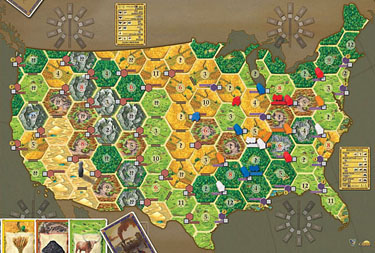
Catan Histories: Settlers of America — Trails to Rails is my favourite flavour of Settlers of Catan. What? A fixed board? With fixed roll numbers? That torpedoes the best part of Catan —the agonizing decision of where to place your first Settlement after analyzing this particular island's geography of productive nodes— doesn't it?
Not at all. It extends the Catan-y goodness.
First of all, the board is huge compared to traditional Catan. Second, there are some spots for random number tokens on the board. Third, the fixed terrain hexes nicely simulate the geography of the United States.
I love the wide open board. I always find the size of Catan Island claustrophobic. I know, I know. Building spots need to be rare for game balance, and fresh real estate is hard to come by in the Old World. I guess I'm an American at heart.
Although the basic mechanic of this game is the same as the original, Settlers of America adds new kinds of building and movement. Wagons and Trains are built instead of Settlements and Cities. Given enough Wheat, Wagons sally forth to establish Settlements. Given Coal, Trains chug along Rails (Roads) you and others have built to deliver Goods to Settlements. Most interestingly of all, as new areas of the board are settled, the east-most number tokens are repositioned. Slowly the east becomes depleted of resources, and the west flush with them. Go west young board gamer.
After playing, the board looks like Catan, but so much more has happened. You've driven wagon trains west, founded towns, and become a railroad baron. Settlers of America is a detailed and satisfying simulation that plays really well. Unlike many game expansions* that add complexity, these additions (e.g. Coins that can be used to buy Resource Cards) smooth and enhance gameplay rather than simply embroidering it.
* note: Settlers of America is a stand alone game. A copy of The Settlers of Catan is not necessary for play.
May, 2014
Sometimes a Snack Will Do

A little restaurant I used to frequent served a menu item it listed simply as, "a delightful little pie." Tsuro is a delightful little game. Simple, quick, light, engaging.
Players lay tiles to simultaneously build and navigate a maze. Styled after the tangled strings of Chinese fighting kites, you zip along a line of loops and curls. Create a path that keeps you flying, and create paths that crash your opponents.
Need a game to fill 15 minutes? That all ages can play? For up to eight people? That includes a mere handful of pieces and takes less than a minute to set up? Tsuro is your game.
May, 2014
Conspiracy, 21st Century Style
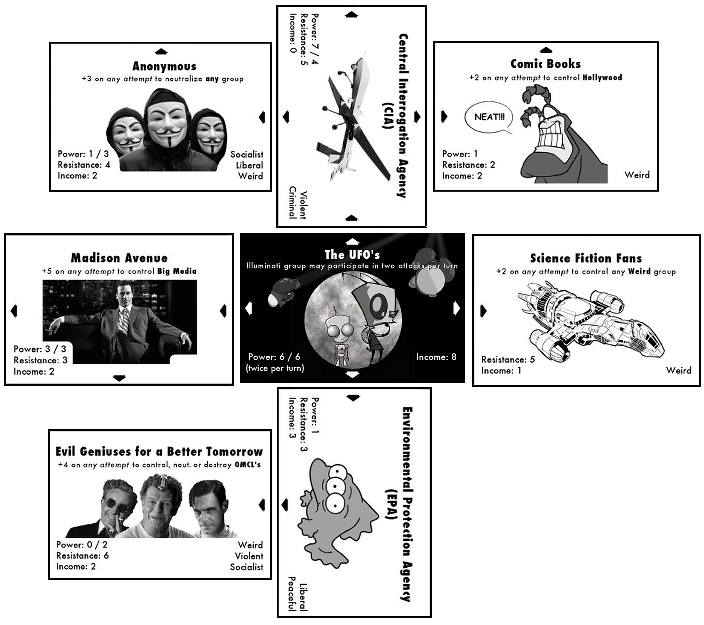
Eve of Destruction is based on the classic card and dice game, Illuminati. It has all the charm of the original but has been updated to poke fun at today's politics. It's chock full of pop culture and social satire.
It also sports a twist. The fate of the world is on the line as never before because the game introduces a new Illuminatus, The International Panel on Climate Change. They attempt to save human society from ecological disaster but must do so in competition with the nefarious forces of greed and power that have always sought to control humanity. Can the I.P.C.C. enlist the help of the E.P.A. to control the I.M.F. and the C.I.A.? Or will Cthulhu order the Aristocrats and the Juggalos to eat them for lunch?
Each player builds a power structure of nefarious groups, one puppet controlling the next, all controlled from the shadows by one of the Illuminati. Although die rolls govern conquest, rolls can be modified by spending the income each group generates. Spending is open to all players, however, so the game is full of horse-trading, alliances, and the inevitable betrayals that follow.
A system of alignments also modify attacks so that structures grow 'realistically.' For example, it would be wrong for Feminists (Socialist, Liberal and Peaceful) to easily gain control of the Pentagon (Conservative, Straight and Violent) but perfectly understandable for them to infiltrate the Worried Health Organization (Socialist and Liberal). A tiny bit of verisimilitude is always necessary to leaven satire.
Dissembling and nervous paranoia balance the chuckles and grins. Eve of Destruction is difficult to win. Get too strong and the other players will gang up on you. The rules are simple and flexible so play is free-wheeling —plenty of ways to appear to be helpful or innocuous while building up to a killing manoeuvre. Each Illuminati has its own winning conditions: control so many groups of this or that type, destroy so many groups, etc. The loudmouth at the table (usually me) will typically alert others when one player is getting too close to victory. (Another opportunity for misdirection!)
Eve of Destruction isn't for sale. It's a labour of love I undertook to share with my gaming friends. Get yourself a copy of Illuminati proper if you're curious and/or click through to see complete (printable) EoD game materials.
May, 2014
Life Is Short, Timing Is Everything,
Neighbours Are Annoying
(Why Do They Keep Taking All the Wood?)

Farming in the 17th century was far trickier than it looked. After playing Agricola, I understand this.
Mastering this worker placement game is devilishly difficult. A range of goals and priorites pull you in different directions. Plow fields? Expand your house? Build a stable? Build an oven? Or go fishing to feed your family? Everything needs doing at once. However, actions have to be taken in the right order, and at the right time, and often aren't available if another player has already grabbed them.
And before you know it the game is ending!
The game starts slowly — early rounds are padded with extra turns to establish your homestead and food production. But as your family grows, you need more food and those extra turns disappear.
To score well, you need a balanced farm. Getting everything built, populated and planted so that it all peaks in the final crescendo of the game... did I already say devilish?
Setting this game up takes a bit of time (although not as much as sprawlers such as Twilight Imperium, Sid Meier's Civilization: The Board Game, or Firefly: The Game [in the cupboard]). It scales ingeniously for 1-5 players using reversible game boards and numerous decks of cards. The decks tune the complexity of play as well as scaling it; building the decks necessary for a particular configuration takes almost as much concentration as playing the game. The game's numerous pieces also require organization. Between rounds the game board must be salted with an increasing variety of resources. We delegate this process to simplify it (I traditionally take care of the sheep and the fishing hole).
Like all great games, Agricola is endlessly replayable. The decks are so deep —the game sports over 300 pre-industrial farming skills and devices— you'll always play with new powers (feudal farming powers!) and rarely see the same ones twice.
Even when you play without these decks (when learning the game or when wanting a shorter play) game-end often begs, "Rematch!" so a player (I) can re-attempt this or that with better timing... if only they (I) can collect enough wood!
peevish note: Don't be fooled. Despite what some say, the name of this game does not have a "grik" in it. Properly pronounced <wink/>, it rhymes with a popular and tasty carmel-coloured soda.
May, 2014
Feeling the Pain of the Triage Nurse

Pandemic is a co-operative game. Huh? Players don't compete against each other? They work together against the game? The lose together, and win together? How can shared victories possibly satisfy? Try this game and see! It regularly provides the most fun, most nail-biting, most triumpant wins, AND the most fun, most nail-biting, most crushing losses, of any board game I play.
This game is superbly educational —don't tell the kids. The world's largest cities form the map. There they sport contemporary names, Kolkata instead of Calcutta for instance. Gameplay involves locating random cities, so every game is one big (fun) geography lesson. In addition, each city card lists that city's population and population density (as of 2013 for the second edition). To begin the game, players must identify the largest city that has been dealt to them. The lesson continues, "Wow. New York is bigger than Mexico City. But Seoul is bigger still. And Jakarta beats them all."
You play against the clock; there are only so many turns to find cures to four deadly diseases. You play against those diseases; if they spread too far across the globe, you're done. You play against virulent caprice; at any time new outbreaks can appear. And you play against limited resources; you can only be in so many places at once to keep infection from cascading out of control. Efficiency is the essential tactic for this game. There are so many ways to lose Pandemic, not a turn can be wasted.
It is often not possible to help an infected city AND pursue the next stage of a cure on the same turn. It's difficult to leave a city where millions are suffering under a pile of brightly coloured disease cubes, but sometimes that's what must be done. Again the game teaches: this time the lesson of triage.
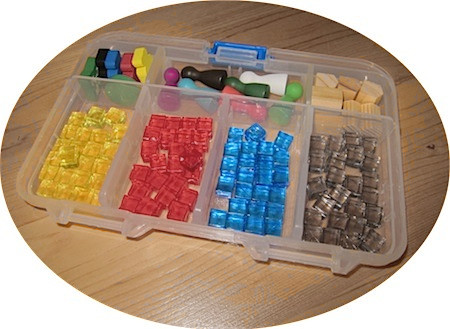
For a game that relies on dozens of tiny cubes, this one sets up and cleans up quickly. There is some initial set up, but most cubes make it on and off the board gradually as part of play. Visit the fishing or beading sections of your local discount store and get an organizer to manage game pieces. Or get the Pandemic: On the Brink expansion (one of the best and most essential expansions for a board game ever made) —it includes petri dishes for storage!
The game is also compact. Its game board is modest in size, despite containing a world map, several counters and spots for cards. I really appreciate games with fewer pieces and smaller footprints. Somehow they're friendlier. We live in a small house where such things matter. In fact, this game is so table-friendly there would be room for snacks and drinks on the game table were it not for the most important rule of gaming: NO SNACKS AND DRINKS ON THE GAME TABLE!
What's remarkable about this game, apart from the fun, is how precisely calibrated it is. Games are often won or lost at the last possible moment. Pandemic is a triumph of game design.
addendum: a number of Pandemic variants are surveyed below in the review of Fate of the Fellowship[in the cupboard].
May, 2014
Flying Hordes of Marauding Fun
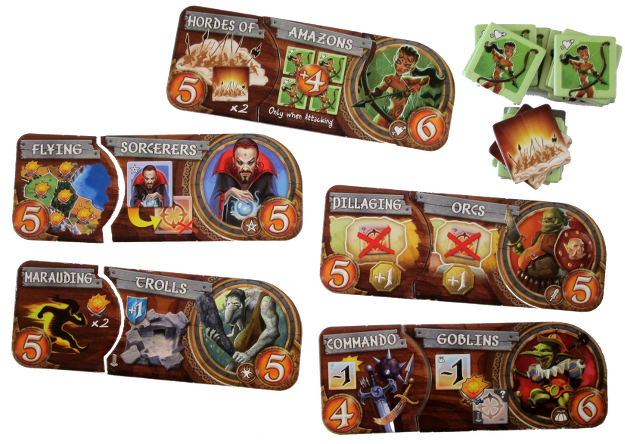
What a wicked mechanic. The magic of Small World (pictured here with some of the Cursed expansion) is baked right in. The simple expand-exhaust-retire mechanic of this game creates a subtle and intriguing game rhythm unlike any other: an ebb and flow that must be yielded to and, if mastered, may be surfed to victory.
I don't generally enjoy area control games. A war gamer I am not. But I love this game even though it is about the conquest and control of territory. Because, it really isn't. Territory is so easily won and lost that your dominion over it is fleeting. Easy come, easy go. Again, what the game is really about, is learning to ride that flow.
As in all things, this is easier said than done. Conquest proceeds in any number of ways given the multitude of Races and Special Powers in the game. At the start of each game, Races and Powers are shuffled and then combined. Spotting powerful combos is one thing. (Some particularly nasty combos are shown above!) However, grabbing the right combo at the right time is another. Board position, stage of game, the other combos in play, your current combo's strength, turn order... all of these factors are important when choosing a new Race/Power. This game has massive replayability.
And there are many game expansions. New Races and Special Powers, new boards, new game elements... but for me, the original game needs no additions, although I do enjoy the Cursed expansion* (2 new Races, 5 new Powers).
* The original game's organizer tray will fit the Cursed Races too! Click through for a printable tray key that shows how.
May, 2014
The Hexes of Burgundy

As you can see by the games in our cupboard, we like Eurogames. The Castles of Burgundy is a doozy of a Eurogame. It is so abstract that attempts to explain it inevitably end, "Let's just start playing. You'll understand how everything works by the end of the first round."
Keep the rules handy regardless. There are still fiddly bits. Although the game takes a valiant stab at developing a symbolic language of its own, many of its symbols need explanations. Luckily, the rules are very well laid out and provide ready reference.
Technically this is a dice game. Don't run away though. While the vagaries of your die rolls may thwart some of your immediate plans, there are always many other paths to points and victory. Possible actions are often so numerous, in fact, that they ramify beyond calculation, especially because, with skill, many actions can be daisy chained to extend your turn. If you absolutely MUST have a certain roll, however, you may use resouces to modify the results of your roll. You may sometimes also secure the power to modify your rolls without spending resources. Take that you lousy dice.
This game manages turn order in an interesting way. Going first can be important, especially in a two-player game, but it's not as important as it first appears. I've gone fourth for an entire game and still won. The game scales very well from two to four players. Sadly, it tops out at four. Playing times increase with the skill of the players and typically exceed those listed on the box.
The Castles of Burgundy is fun, challenging and the many different player boards keep the game fresh. Interested in running an estate in 16th century France? Read a book. Interested in a great strategy game? Play Burgundy.
May, 2014
Firefly: A 'Verse Full o' Cards
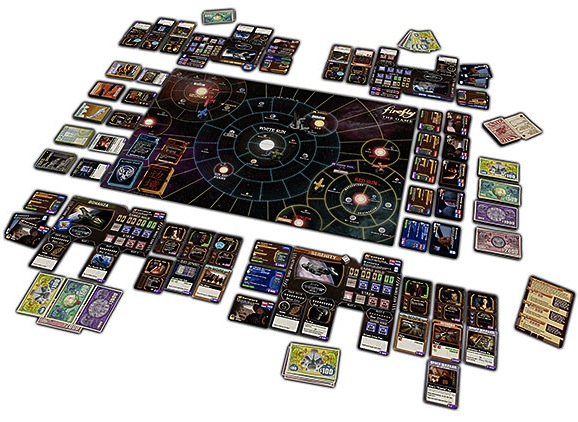
Best. Themed. Game. Ever. Based as it is on the best TV show ever, how could it not be? Yes, I'm a Browncoat. That may make me biased, but it also enables me to declare this incarnation of Firefly, shiny!
The production values of Firefly: The Game are high and pitch perfect. All game parts (and there are many!) show real affection for the material. Game play is simple but effective. Players toodle around the 'verse avoiding the Reavers and the Alliance while trying to earn some scratch. Victory is achieved by satisfying a number of Story Goals before your opponents do. A number of different Story Cards come with the game to mix things up. I like this variety. More importantly it reinforces the narrative backbone of the game, and offers players the chance (outside of normal game play) to make up their own Stories — check the forums at boardgamegeek.com!
There's a definite early-game, mid-game and end-game to Firefly. Most of the early-game is spent hiring crew and scrounging for gear. However, who and what's available to you is random. Even if you camp out on Persephone or Silverhold, mining their spaceports and saloons for the Tams or for Jayne and Vera, there's no guarantee those good folk will cross your path. Sometimes marquee crew show up all at once. It's not unusual early in the game to look at another player's Firefly with envy. You hired Wash AND Kaylee? Cai bu shi! (No way!)
The mid-game is typically spent making money — most Stories require lots. With a good crew you can get rich quick. But the mid-game is long (playing times for the game well exceed those suggested) and this is where game balance is achieved. Choose jobs that suit your crew and route yourself efficiently and you can keep pace with those sporting fancier duds. There's plenty of time to beef up your crew, or even re-tool it completely to better tackle the next Goal. Take the long way between planets to avoid the Alliance Cruiser and watch with glee when it descends on a cocky Firefly and confiscates their contraband. There are a number of dangers that can set an unprepared player back hard; keep a Cry Baby on hand at all times.
There is little player interaction in the game, and therefore pitiful few ways to keep those scoundrels captaining the other Fireflies in check. When my group first started playing this game, we feared runaway victories. Extensive play has proved the opposite. Most games finish very competitively. The end-game starts suddenly, like the sprint at the end of a bike race, and just like cyclists waiting for the breakaway, players are almost always ready to attempt the final Goal on the same turn, or within one turn of each other. Even if you do get left behind, you never feel left out. It's just so much fun being the captain of your own Firefly!
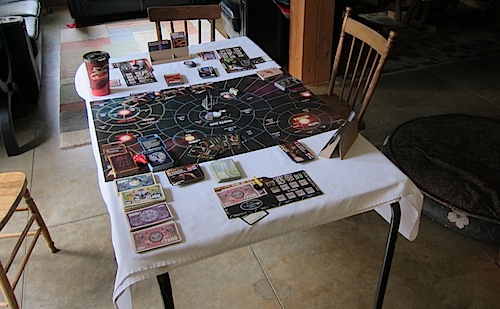
It really is possible to experience the magic again. Maybe it's just the way my imagination works, but I feel closer to the gang and their travails playing this game than reading the Dark Horse comics. Even for folks who aren't fans of the show (a hypothetical group, because I've never met such a person) the game will be fun. It's a well balanced pick-up and deliver game that plays loose, if a little long. Loose is good, a nice antidote to precisely timed Eurogames. And long isn't bad, when you're having this much fun.
Note, this game requires a table as large as several star systems. The publishers have announced an expansion called Firefly: The Game – Blue Sun [now in the cupboard]that increases the size of the game board. Despite our tiny house I will buy that expansion. Firefly is that good.
May, 2014
What Kind of Gamer ARE You?
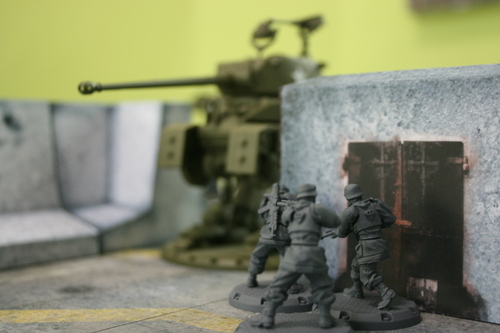
Dust Tactics is a great introduction to miniatures gaming for board gamers. Like the child of an Olympian and a mortal, the game combines the best attributes of wildly different parents. Play in DT does away with the fussy and quarrelsome measuring tapes of Father 40K and proceeds instead on a grid of squares more like Mother Monopoly. Actually, forget Monopoly. Think Chess with ranged weapons. (Note: if the gods play games —and by definition they do— they would surely prefer toying with miniatures!)
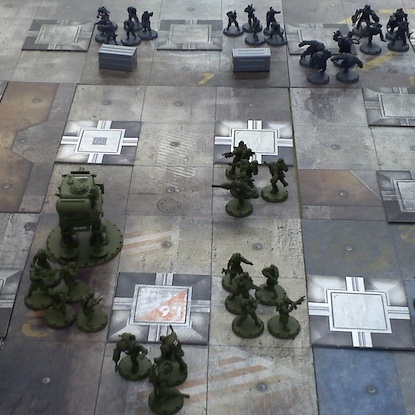
Minis are great and tactical skirmishes are fun, but the reason I play DT over, say, Warhammer 40K, is because of Dust's backstory. It's well developed, riffs on history in a very detailed way, and has a great pop sensibilty. Most boys of my generation are attracted to WWII history. Most geeks of my generation adore alternative history plots. I painted model tanks as a young teen. Mech walkers with WWII armour and ordnance? Sign me up!
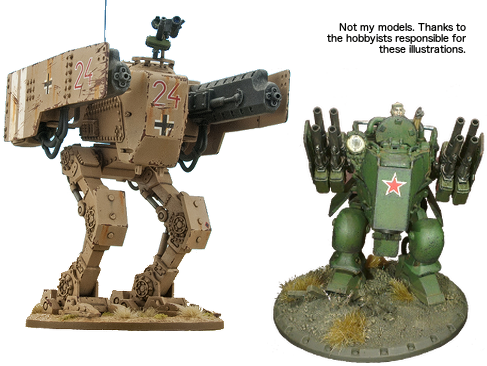
A note for parents and teenage boys: Dust is for adults. Just as the weaponry in the game is exaggerated, women and men in the game are depicted as hyper-feminine and hyper-masculine according to traditional, heterosexual tropes. More plainly put, the game sexualizes women. The women in the game have huge breasts, wear tight clothing and strike provocative poses.

It's important to understand that these depictions are meant to evoke the pin-ups of yesteryear (a time that was more sexist than today — although by just how much is debatable), and that the nostalgic and over-the-top tone this sets is part of the playful, alternative-history proposition of the game.
This can be difficult to remember, however, because of the distracting nature that huge bazookas present for straight men. Undoubtedly, this art is meant to titillate and this is especially problematic given that a primary audience for games of this type is teenage boys. The historical elements of the game are similarly problematic (see my essay on Nazis in Dust). For these reasons I don't recommend this game for youth unless they've been engaged in conversations about sexism and the Holocaust.
Cool minis, hybrid gameplay, rich backstory... as great as DT is, its rules are in a bit of a tangle. Miniatures games are susceptible to such tangles because of model-creep. As more models are released for the game, they add new capabilities that require special rules. Not only is the growing rulebook difficult to stay on top of, the new specials dilute the army you've already invested in. From time to time, publishers correct these schmozzles by rebooting a game with a new rulebook that harmonizes the stats of units new and old.
As of this writing (Aug. 2014), DT is suffering through one of these reboots. The game recently changed publishers and the new publisher, Battlefront Miniatures (BF), has taken the logical step of issuing Version 2 of the game. Version 1 models are still being sold, however, by the previous publisher, Fantasy Flight Games (FFG). Of course, the models themselves play just fine regardless of version, but the FFG kits come with V1 rulebooks and V1 cards. BF is not yet selling models themselves, but has released V2 rules and V2 cards (labeled "2014") so that players can upgrade their armies.
[UPDATE 2016: BF no longer sells DT. The Kickstarter campaign for Operation Babylon (May 2014 - October 2016) blew up their relationship with the game's creator, Dust Studio. Dust Studio limps along producing miniatures without a major distributor and presence in the marketplace. Dust Tactics is effectively extinct.]
[UPDATE 2022: I was wrong in 2016. Dust Studio persevered. It refreshed the rules of DT and renamed the game Dust 1947. It shifted to directly selling its products online, then through three regional licence holders (U.S., Italy, Poland), and eventually through a substantial network of retailers. It released several more chapters of the Dust story (after Operation Babylon: Operation Kondor, Operation Hellgate, and Paradise Lost), and many more waves of minis. However, I can now, sadly, report the demise of Dust. On September 29, 2021, Dust Studio announced it was ceasing operations. They cited shipping and manufacturing problems caused by the COVID-19 pandemic as reasons for their decision.]
Unit cards are another way this game simplifies battle. Each unit has a card that summarizes their abilities. There is no need to crack the rulebook or a binder of charts during a game. Beware, V1 and V2 cards have very different stats for the same unit. Be doubly ware, the earliest V1 cards (V0?) sport different numbers still, and early V2 cards (2013) are different again!
(I told you DT is in a mess at the moment.)
I don't know how to tell V0 and V1 cards apart, but you can tell V1 and V2 cards apart by their size. V2 are smaller and double-sided. Early V2 (2013) cards list a unit's Damage Capacity in the upper right corner (along with Move and Armour Ratings), while the current cards (2014) relocate that stat to the bottom of the card and display the unit's March Move Rating up top instead.
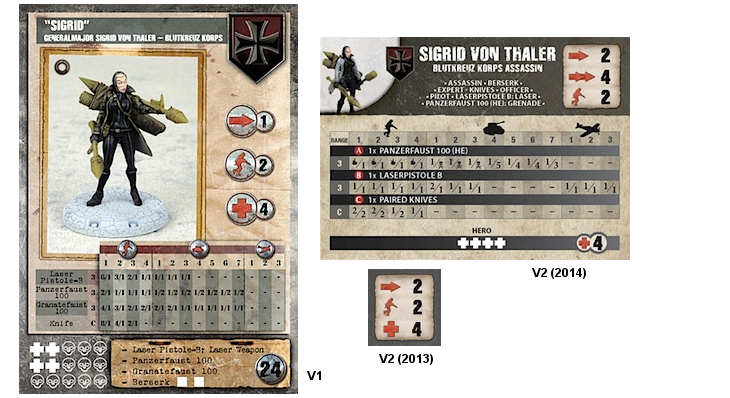
I like the new rules. They streamline the game, and simplicity is one of the reasons I chose Dust Tactics in the first place. The game plays fast, 45 minutes to 1 hour per battle. Plastic in. Plastic out. "Let's adjust our armies and play again!"
The only problem with adopting V2 rules is that doing so makes playing the many existing V1 campaigns difficult. There is much fun and flavour to be had in those 'famous' battles. They are, in order:
- Operation Blue Thunder - skirmish in Antarctica
- Operation Cyclone - counter-attack in Antarctica
- Operation SeeLöwe - invasion of Scotland (with Zombies!)
- The Victory Bridge - bridge battle in Southampton
- Operation Cerberus - urban warfare in southern England
- Operation Zverograd - all out urban warfare with air support
- Operation Hades - claustophobic battle in the sewers under Zverograd
- Operation Icarus - an airfield raid outside of Zverograd
- Operation Achilles - bunker assault at Zverograd Terminus
- Operation Babylon (V2) - the North African front re-opens
Check them out for the whole Dust story. To play these campaigns with V2 rules, check out these adaptations. Or try my V2 campaign:
- The Battle of Darien Gap - jungle warfare
August, 2014
Smashy Smashy

King of Tokyo is a hoot. Who hasn't dreamt of climbing inside a thick rubber suit that severely limits your visibility and slap fighting into submission a number of foes similarly encumbered?
In this game you play one of several kaiju, the giant monsters that ravaged Tokyo on TV most Saturday afternoons the year I turned nine. You roll six special dice to build sets of claws, hearts and lightning bolts that let you attack your opponents, heal yourself and collect energy cubes. You can also roll numbers to collect victory points. Energy cubes may be redeemed for cards that grant victory points, destruction and special powers for your monster. Gather enough victory points to win, or drain all of your foes' health to be the last kaiju standing.
This dice mechanic mimics the mayhem inherent in the theme of the game. It makes play physical and it makes it fast. Luck and fancy rolling heighten the drama. Knock-out punches can come out of nowhere, as do evil laughs and cries of mock anguish. Games tend to be noisy.
Lighthearted as the game is, it has some stategic depth. Given the vicissitudes of dice, you must adapt and at other times focus. It's difficult to manage your health when there are so many ways to push your luck. Many of the special powers available in the game take skill to play well, and often distract you from more important things.
Play King of Tokyo with two players for longer games that make more use of special powers. Play it with more players for shorter, rowdier games. In large games the odds of multiple KO's increase!
January, 2015
Hail Caesar!

Augustus (sold as Rise of Augustus in the U.S.) is a handsome game. It takes after its namesake, the first Emperor of Rome. Its artwork is sumptuous, fit for a patrician. Yet the game is also practical —just as Octavian was in dress and manner— because its pieces collapse into a very small kit.
Augustus is my favourite type of game: fleet of foot, deft of carriage. It sets up in a jiffy and plays just as quickly. The bingo-like mechanic at the heart of the game encourages simultaneous play and quick decision making.
Fear not, the game is more sophisticated than bingo. Players choose their own cards strategically from a variety of types, juggle different odds, and may adjust their 'daubs' depending on circumstances. Completing a card secures a number of points, effects and bonuses. Some cards even allow for attacks on other players' cards. Best of all, with careful play, completions can be strung together for ascendancy, two-hundred years of peace, and the glory of Rome.

The game does, however, depend on the random generation of symbols (sturdy discs pulled from a bag) so despite your best laid plans Fortuna may turn her back on you and make it impossible to complete your objectives before your opponents do. Such is life. The game styles itself as a political contest between young senators vying for consulship by gaining influence over other senators and Roman provinces. Like politics today, ancient politics was a fickle game.
For some, this might be the Achilles heel of Augustus (mixed civilizations notwithstanding). Some games of Augustus will be lopsided (although many are close). My partner and I get around this problem by playing multiple games in a row. Because Augustus plays so quickly, a best-two-out-of-three is easy to finish in one sitting and we find this evens things out. We do not feel the game is unbalanced or that the sometime blow-outs spoil play.
Augustus is a very polished game. My only criticism of the game is that it's packaged in a standard sized box. I understand the marketing and tooling reasons for this, but my game shelf is too crowded for storing boxes three-quarters full of air. I buy games based on reviews of their gameplay not on how many pieces they contain, and am willing to pay full price for a good game regardless of the size of its box.
January, 2015
Firefly: The Expansions
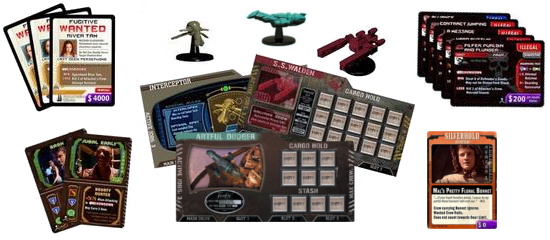
To date, three official expansions for Firefly: The Game [in the cupboard] have been published, as have a number of promotional add-ons (which have now made it to retail) such as The Artful Dodger, a new ship card and model; Big Damn Heroes, replacement cards with an additional income bonus for the crew of Serenity; and Mal's Pretty Floral Bonnet, a new gear card. I haven't played any of these add-ons but I have played each of the expansions. They amount to (in release order): more cards; more ships; and more 'verse.
Breakin' Atmo consists of several new cards for each of the Supply and Contact decks in the game. As such it adds new Jobs, Gear and Crew to the game.
Pirates & Bounty Hunters is a more ambitious addition to the game. It attempts to address the common complaint that the game lacks player interaction by adding Jobs and new Boarding/Showdown rolls that let you steal stuff from ships in your sector. P&BH also adds a new deck of cards to the game which target three Crew at a time with Bounties. Capture these folks from a Supply Planet or another ship and deliver them accordingly to make some extra scratch. Last of all, the expansion adds two new ships to the game, Early's small but fast Interceptor and the Scrappers' large but slow scow, the S.S. Walden.
Blue Sun adds 33% more 'verse to the game! This new territory, Rim Space, includes two new Contacts, a new Supply Planet, and a new home for the Reavers who now maraud in three, 3, yes THREE Cutters. That's two more game board panels, four new decks of cards and two new ship models to fill your gaming table with.
Game expansions can be problematic. When a game sells well, game designers have an incentive to leverage that success with some sort of addition to the original game. Fans of the game are also inclined to want embelishments. But more times than not, in my experience, game expansions break the delicate balance of game play that made the original game a hit. More is not always better. I value elegance and simplicity in things. I prefer games with simple mechanics that yield deep play, rather than games that try to create depth with lots of detail. Event Cards, Action Cards, Whatzit Cards, ack! Too much to read, too much to grok. More importantly, too many layers can make play muddy.
With these biases in mind, I can report the expansions for Firefly are, by and large, terrific stuff. Breakin' Atmo in no way alters the feel of the original game. It simply extends the game's shiny goodness. The 'combat' in P&BH slows down the completion of most Story Cards but doesn't unbalance the game in favour of those who like beligerent tactics. Attacks are fun, but they're risky. The expanded 'terrain' in Blue Sun actually makes the game feel even more like the TV show. Long haul jobs now exist that make the 'verse feel truly big, and your little lifeboat small and lonely. The extra Reavers in Blue Sun create an ever present threat that also slows the game but better simulates their presence in the show.
The only additions to the game that don't work well are the new ships (the Intercepter and S.S. Walden). While they are useful for certain tactics, most of the game's Stories favour versatility. Firefly class ships, generalists that they are, still rule the sky. In particular, the scow is difficult to play because it becomes a target for pirates. This is thematic for sure, but can unbalance the game. People who like variety and like a challenge will enjoy trying to captain these ships. With the right Upgrades they can compete, but even experienced players who know where to look for those upgrades might not be lucky enough to find them.
January, 2015
Finally, a Realistic War Game
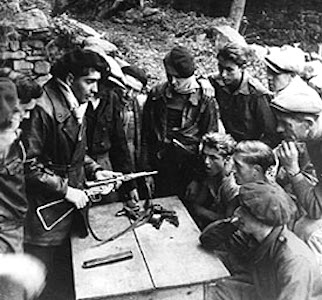

The Resistance is game of deduction for 5-10 players. It is a 'social' game that relies on lots of free-form player interaction in the form of accusations, professions of innocence, misdirections and lies of other sorts.
Players are randomly and secretly assigned roles: most are loyal resistance fighters, but a few are spies who will work against them. Together, in a series of rounds, all players elect teams to attempt 'missions.' Once a team has been chosen, the elected players each secretly vote to fulfill or scuttle the mission. Resistance members always vote for the mission to succeed. Spies can vote for it to succeed or fail. When a mission fails, who at the table was the spy who sabotaged it?
This game is fun. It encourages suspicion and lots of fine acting. It's easy to teach and plays quickly. As light as it is, however, it's engaging and addictive because of the simple tactic inherent to it. Players instinctively understand their job is to rotate the mission teams to corner and isolate the spies.
It tickles me that this very tactic is a proven one, practiced out of necessity by real resistance cells thoughout history to neutralize the threat of infiltration. Without resources, a small group of people largely unknown to each other can protect themselves from spies using the process laid out in this game. Gaming makes history come alive again!
There are several expansions to The Resistance that add player types and actions that assist and complicate deduction. Check them out: The Plot Thickens, Hidden Agenda and Hostile Intent. You can also play the basic game with two decks of playing cards. That's a variation I call Sabotage!
March, 2015
In Praise of Card Games
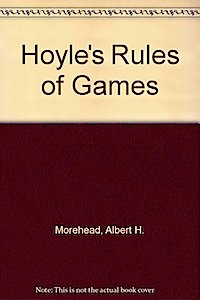
On most school nights when I was nine and ten years old, after putting on my PJs, I would join my parents and my brother in my brother's room, and we would sit on and around my brother's bed and play card games. We played Go Fish and Crazy Eights, then Hearts and finally Casino. Lots of Casino. In later years, we played some board games (Monopoly, Clue, Scrabble) but they never took like the card games did. They never became a routine, a full family thing. Perhaps it was the need to clear a table, or the longer play times, or the calibre of games available in the early 70's. We just didn't transition our games ritual from cards to cardboard.
Of course, we all know what happened next. Risk. Dungeons and Dragons. Video games. And then, years later, The Settlers of Catan*.
Things have come full circle now. Contemporary game designers embraced cards a while ago. Puerto Rico begat San Juan which begat Race for the Galaxy which begat Dominion. Sort of. Well not really, but who can resist a string of begats. In any case, then Seiji Kanai begat Love Letter.
The birth of Love Letter confirms we truly are living in a golden age of games. It is a true classic. Simple, elegant, fun. Like any beauty, obvious and instantly familiar. Belonging to "where have you been all this time?" and "why didn't I think of that?"
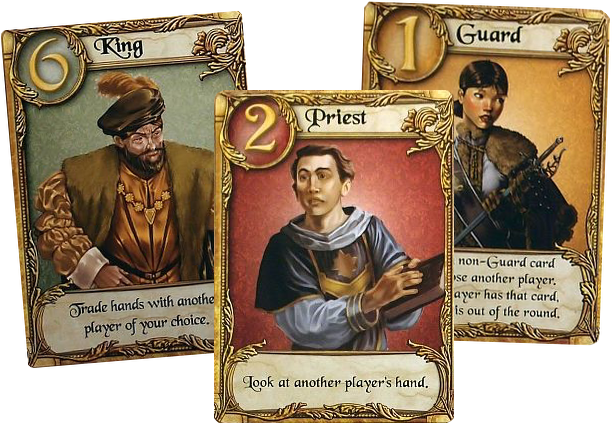
Love Letter is a deduction game for 2-4 players. Sixteen cards represent the members of a royal court each with a power of their own. Some snoop, some trump, some need your protection. You hold one card until your turn when you draw another, then decide which of those to keep and which to play. You are vying for the affections of the Princess and seek to eliminate your rivals by, for instance, challenging them with a Guard or intimidating them with a Baron.
Each card has a rank too. If you fail to eliminate your opponents, you can still secure a point by holding the highest ranking courtier at the end of a round. Most importantly, all cards played remain visible. As in any co-dependent group, careful attention to the actions of others will allow you to discern their motives, the better to push their buttons.
The theme of this game is delightful. It is so strong, so embeded in archetype, that the game has spawned endless loving re-themes. Most of the images posted to Love Letter page of boardgamegeek.com are about such re-themes, not the original game. Here's my contribution to the genre, Good Help Is Hard to Find.
And if you thought this game couldn't get any better, it does. The whole thing packs into a small pouch tiny enough to fit in a pocket! This is one the virtues of card based games — they don't take up much space in the cupboard.
It's not just nostalgia that makes me fond of card games. There's lots of good gaming here. Anyone serious about gaming should mix up their play with some modern card games. They're great palate cleansers. Great openers and closers. And they're closer in feel to board games than you might think.
* [A version of Catan, Catan: Settlers of America, is in the cupboard.]
March, 2015
For the Coup Crew
(and Those New to Coup Too)
You're in Guatemala. It's 1954. The CIA and United Fruit Company are flexing their muscle. Prepare for maximum Coup.

Coup: Guatemala 1954 is a tremendous bluffing game for 3-6 players. Based on Coup from 2012, G54 is a mix of strategic and social gameplay, less of a party game than The Resistance [in the cupboard]; a little meatier than Love Letter [also in the cupboard].

A small deck of cards contains a variety of rolls each possessing a power in the game. Players get a hand of two of these persons and each turn can execute one of their powers. Bankers earn money. Politicians take money from other players. Guerillas kill another card for you if paid a fee...
All of these actors operate in the shadows however. They keep their cards close to their chests, and so do you. You see, you claim a power without showing your hand. If unchallenged, your action proceeds regardless of whether or not you actually have the card you claim to. If another player smells something fishy however, they may call you out. If you were bluffing, you lose one of your cards. Lose both, and you're out of the round. If you weren't bluffing, the challenger loses one of their cards. Rounds are fast. Players jockey for position. Suspicions abound. Death comes suddenly and unexpectedly from people you thought you could trust!
There are five rolls at play in each game with each roll represented by three cards. In the original Coup only five rolls existed. In G54 twenty-five rolls exist letting you customize play. Play with the basic characters if you're fond on the original Coup*, or if you're tired of that, mix things up with characters who have new tricks up their sleeves.
G54's expanded deck extends re-playability and deepens the theme of the game. I love the many rolls and the narratives they create. Yes, the army will be killing priests, communists will be helping fund protesters, and the CIA will be feeding stories to the newspapers. I love the game's artwork too. Somehow it evokes the past, familiar but faded. Coup: Guatemala 1954 is a great addition to the Coup family of games. It's a must for Coup aficionados and the Coup-curious too.
* note: The rules of Coup and G54 differ in the way certain roles block other roles, so the basic configuration of G54 can't exactly re-create the play in Coup, but this difference is so slight it's trivial, and in effect the games play identically.
March, 2015
Adapt or Die Lose
Get ready for player interaction! There is no such thing as turtling in Evolution. (Well, actually there is, if you get the Hard Shell card.)

Evolution is a fantastically simple and fluid game that simulates, wait for it... evolution. Players grow species that compete for food. The more you eat the more points you score. You also get points for increasing the populations of your species. A larger population can eat more food/points for you. But they can also starve and die back because food can be scarce. Ah, the joys of gaming. You gotta get to the chip bowl before Tom does.
To out-eat your hungry neighbours (in the game), you can evolve your species with a variety of traits. Add the Foraging card to one of your species and it will eat twice as fast. Add the Long Neck card, and your species will be able to nibble tree tops and take an extra food before regular feeding begins. Play the Carnivore card and your species will be able to eat meat, i.e. the other species at the game table!
Once a carnivore is in the game, Evolution really takes off. Many trait cards offer protection from carnivores, e.g. Climbing, unless of course, a carnivore plays the Climbing card too and evolves the ability to hunt in the trees! A player can also protect a species by evolving it a larger body size. Then again carnivores can get bigger too. As you can imagine, an exquisite arms race ensues.
The interaction between species can be intricate thanks to the variety of trait cards. Combinations are lavish. The strategies they suggest tantalizing. Sadly, this game takes place in the jungle not a terrarium. There just isn't time to evolve the perfect set of organisms because circumstances are constantly changing around you. No other game I've played requires so much attention to the actions of all other players.
Evolution took our game group by storm. It plays 2-6 in about an hour. Two-player games feel a bit cramped. The game sings with three or more players. It plays quickly and smoothly especially for a game that encompasses such complexity and so many winning strategies. It's easy to teach, because of its strong theme and simple rules. However, because of the many trait cards and many useful combinations of traits, Evolution has a steep learning curve. People will want to play it again immediately after their first game (and after that one too!) as they grok the game's potential and start to formulate growth strategies.
Evolution is a remarkable game, a perfect marriage of theme and mechanic. It feels right, real, like building and managing an actual ecosystem. If you ever wondered if playing God would be fun, it is!
note: The game pictured above is my print-and-play version of Evolution, not a retail copy of the game.
April, 2015
A Horse, a Horse. My Kingdom for a Horse.

Sometimes you buy a bad game. Kingdom Builder stinks. Everything about it is lame. First of all, the artwork is generic. I'm not complaining that it's abstract; you know I love Eurogames. The art is just flat, plain, dull. Next, the mechanic. It seems fun at first but outcomes are skewed by luck; it's possible to consistently draw non-productive cards. Theoretically this shouldn't happen because the board is large and the goals many, but... it still does. Even the game's most attractive promise, replayability, blows. The mix-and-match powers and goals of the game are so uneven that depending on which ones come up, the game transforms from mildly engaging to flat boring. On top of all this it's expensive. The expansions that marginally improve gameplay are expensive. And it won Spiel des Jahres (Game of the Year) in 2012! Yes, Kingdom Builder won the most pestigious award in all of boardgamedom, which led our friendly local game store to buy stacks of it, which prompted dear friends to give us a copy for our birthdays, which is why this dog remains in our cupboard, and most of the KB stack remains at our FLGS all these years later.
There. I wrote a bad review.
In the scheme of things it's really not that bad. It's just light, very light, and my expectations of the game were high because of the SdJ award and its famous designer, Donald X. Vaccarino. (Vaccarino previously designed Dominion, a huge hit and genre-defining game [mentioned in the Quest for El Dorado review] that also won SdJ.) If the cost of the Nomads expansion were to come down, I'd add it to the game, remove the lame powers from the shuffle, and play the few configurations of the game that provide better balance. How this game won SdJ, I'll never know. I think the jury just didn't play it thoroughly, because, while full of theoretical merit, Kingdom Builder just doesn't come together during play.
April, 2015 / link added August, 2023
A Classic Gets an Update
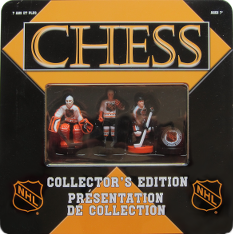
Who knew chess was ameritrash? Think I'm kidding? Check out the finely sculpted and painted models in Chess: NHL Collector's Edition.
I picked this game up because I like chess and I like hockey. Perhaps I should be clearer. I like watching chess and watching hockey. I play neither game well. Weak ankles. Made walking to chess club difficult.
NHL Chess is novel but not in a good way. Although sports contests like hockey can be battle-like, the battle theme of chess doesn't mesh with the scenario of a hockey game. At least not in this implementation.
This is most apparent in the assignment of pieces. Rooks become refs/linesmen, knights become defencemen, bishops become wingers. Fair enough. With only six hockey players per side the refs are needed to pad out the eight ranking chess pieces. But then the insanity begins.
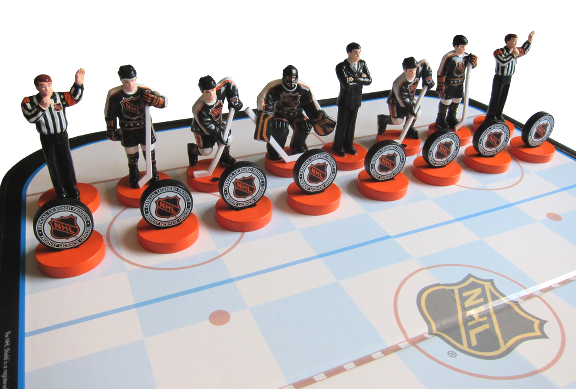
For some reason the center forwards of these hockey teams are both in the penalty box for the duration of this game! Instead of making queens into centers, the queens become goaltenders (because, you know, the goalie is the player that zips around the rink the most) and the kings become... head coaches. What? A guy in a suit is the most important player on the team? Perhaps, in a franchise kinda way. But this game takes place ON the ice (the chess board is modelled as a rink). Get off the ice Coach! What a load of corporate nonsense. Is any more proof needed that whatever Gary Bettman touches, he ruins?
Oh, and the pawns. They're pucks. 16 pucks on the ice at once! Really.
The plethora of pucks I can forgive because of how poorly a hockey squad maps onto the medieval battlefield of chess. With ten too few players for a chess adaptation something had to be done. A row of pucks in front of the hockey team (as theme-breaking as that is) is really the only solution. With a little work I can imagine the pucks existing in different time-lines of the game representing different shots that players near them have taken.
The goalie/queen debacle, I can't forgive. If only the goalies had been made kings, and centers added for queens. Then the game would be all about getting the other team's goalie in your sights to take a shot on goal — check! And checkmate would be the final play when, screen in place, men at the blue line, behind the net and in the slot, a goal is unavoidable, certain, made.
NHL Chess is goofy (always a plus in my mind) but disorienting to play (here's an example of a typical game). Clearly an exercise in corporate branding, I can't imagine it was published in great numbers. We can only hope it found its intended audience and that some of those young boys and girls were intrigued enough by it to try playing real chess.
April, 2015
Analysi Paralysi
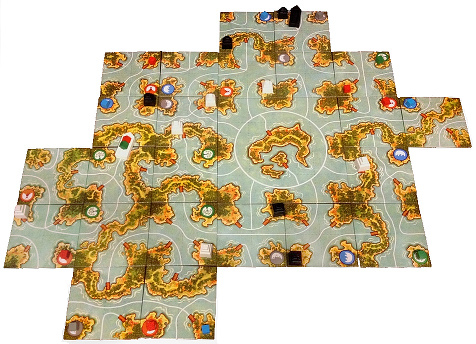
Akrotiri is a beautifully busy board game for two players. It is an elegant combination of many mechanics: tile laying, action pawn, resource management, area control. As such, players have to manage movement, map building, and a simple economy with a limited number of actions each turn. The game's components are varied but somehow not too many: player mats, map tiles, tiny cubes, linen cards, cardboard tokens, weighty ceramic markers, and two cute little wooden boats.
Akrotiri is a very well designed and produced game. AND it packs all these parts into a small box. What's not to like? The designers even found an interesting theme that unifies all these elements.
You play ancient Greek archaeologists competing to locate even more ancient Minoan temples. You must fund your excavations, however, by dragging resources back to the agora for sale. Treasure maps that hint at the location of temples are also available for purchase there. The game is a race to discover six temples and score victory points based on randomized goals and investments in more or less difficult searches.
As the game proceeds, the game board, the Aegean Archipelago, grows. Players lay tiles that suit their exploration plans and their economy. More sea to sail and more islands to search/mine accelerate the game. Discovering temples also grants more actions per turn. This game can end quickly and it's important not to be outpaced by your opponent.
Sometimes a game is too well designed. Too tight. The way the many layers of Akrotiri knit together (combined with the urgent need to keep pace) promotes the dread "analysis paralysis."
Analysis paralysis is an affliction that effects players not games. It is defined as:
Analysis paralysis: 1. the inability to take one's turn given the mathematically dense options for this turn (and later turns) based on the present board state, point totals and resources held (known and inferred) for oneself (and every other player at the table) when playing a well designed Eurogame; 2. the annoying tendency of one's opponent to over-think their turn eliciting whines and taunts to make a move, any move; 3. the need to re-examine all of one's options a second time having lost one's train of thought due to such taunts.
AP is easy to diagnose but hard to cure. I was diagnosed in 2012 during a game of Agricola. Sadly, my condition continues to deteriorate.
Akrotiri was originally designed as a four player game, but the combination of this AP inducing quality and the ever changing board state led its publisher to release it for two players only.
This is the game's weakness. It is just too tightly wound. There is not enough time in the game to experiment with strategies and recover from wrong turns. For some this is a virtue. A shorter game means more plays. Heaven knows I like shorter games.
But this is a heavy game trapped in a short game's body. The way you must keep pace with your opponent often forces your choice of actions. With two very competitive players (like me and my spouse) the game can feel programmed. Still, the game is fun, challenging and varied. It is just so tightly engineered it sometimes feels a little more like a puzzle than a game.
March, 2017
Psst, Buddy. Wanna Buy a Board Game?

Heat is a nifty little card drafting game for 3-5 players. Players build a hand of cards which they then play as a gang to rob banks. A heist provides $$$ for the players depending on which cards they played. It may also bring them 'heat' from the fuzz. Too much heat will cost you.
There is no honour among thieves, however. The effects of the cards are interdependent. For instance, playing the right card at the right time will result in a larger score of loot for you than for your fellow safecrackers. This game is all about table talk. Bluffing the other members of your gang that you're there for them while secretly planning to take all the money and run.
The interdependence of the cards enriches the drafting phase too. You're not just passing potential points around the table. You're also passing/keeping actions that will require coaxing later to be played at the right time to work for you.
I really like micro-games like this. It's available for PnP (print'n'play) on BGG. The artwork is stylish. Print it, sleeve it, try it out!
I bought a retail version of the game when it was available because I hate card sleeves. But that's a topic for another time.
Card sleeves are slippery. They make decks of cards slide all over the place. Card sleeves are bulky. They make shuffling difficult. Card sleeves have sharp edges. They make the tactile delight of holding a hand of cards a nightmare. Still, I do use sleeves for certain precious games. Several members of my game group have nicknames - nicknames I've secretly given them. I call them Mangler, Cupper and Greasy. But like I said, that's a topic for another time. Heat is a great little game.
March, 2017
Strange Tortured Dreams! Fun!

Tajemnicze Domostwo is the Polish version of the Ukranian game Mictepiym which was later published in English as Mysterium. There are minor rules differences between the three games but essentially they play the same way. They are a cooperative game for 2-7 players. The original was a big hit when first released because it combined the dreamy, imaginative, associative gameplay of Dixit with the deductive elements of Clue.
For some, the softer ways of Dixit are mushy, although I think every game cupboard should include this type of game for guests who aren't number crunchers and strategy masters. Tajemnicze Domostwo / Mysterium adds just enough 'game' to Dixit to stiffen it up and appeal to more competitive board gamers.
The game mimics a seance. One player assumes the role of ghost. They cannot speak but must communicate symbolically via a deck of dream cards. Each card is loaded with symbols. Which one is the clue? The wristwatch or the turtle wearing it? Or the overall colour of the card? Or the emotion on the turtle's face?
Over successive rounds, these cards accrete and a meaning emerges. Each non-ghost player is in search of three truths (a person, place and thing) but all are fighting the clock. In the final phase of the game, all players put their heads together to solve the mystery of the haunting.
The wonderful thing about this game is its pace. The ghost feeds players clues as best they can —they are limited by their hand of cards. Discussion among the other players is encouraged, and there is so much to discuss (different people seeing different things in the same cards) that this collaboration nicely fills any gaps caused by the ghost searching for the next good clue. Discussion can begin even before the first clue is given, based on cards dealt to the table during set up!
This relaxed pace and putting-together-of-heads makes the game ideal for groups of mixed age or gaming experience. The inability to communicate with the ghost is frustratingly fun for all, and when played by candlelight it can even be spooky.
resource: For a spooky game screen to help you play Tajemnicze Domostwo or Mictepiym (Mysterium comes with one) check out my extra spooky rendition of the game, Tortured Domicile.
March, 2017
Tiny Treasure
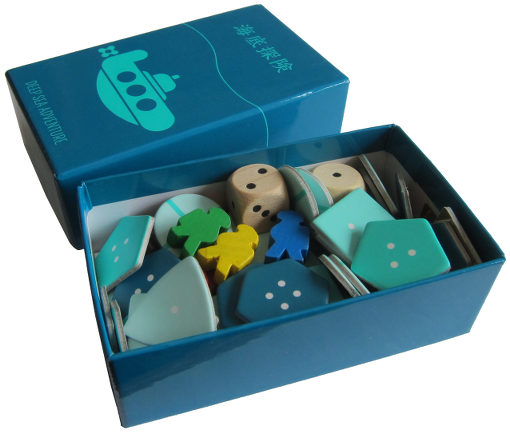
Deep Sea Adventure is a tremendously fun push-your-luck game. Players don diving helmets and plunge from a submarine toward the sea bottom in search of treasure. The deeper they go, the richer the prizes get, but the further they have to swim back to safety. Each dive provides only so much air. Can you get your booty back to the sub before passing out? On top of that, the more booty you carry the more air you use. And on top of that, everyone shares the same air supply.
This little gem is a study in efficiency. It creates an underwater world of mystery, danger and reward with only two dice, 32 little tiles, six player pieces, and one submarine shaped progress track.
The tiles and track serve multiple purposes: 1) they present the challenge of the game - distant treasure, diminishing air; 2) they manage each player's progress as they descend in search of said treasure, then ascend huffing said air; 3) they track victory points, the salvage itself; and 4) they create the game board, a serpentine line of tiles descending from the sub that you can arrange as you like. The tiles are coloured by type, each successive group a darker hue of blue, the better to simulate the water column. This is a very elegantly designed game.
The rules for DSA are similarly efficient.* They are few, straightforward and fit on a small accordion of paper.
This is important because all of these components compact themselves into a tiny box 1 3/8" x 2 1/2" x 4 1/4". This lets DSA offer the most fun per cubic inch of any game in our collection.
If this represents maximum Fun Density (100% FD), then other games have a problem. For example, six DSAs fit inside my new Augustus box. That means, compared to DSA, it offers 17% FD. If left in its original box, 30 DSAs can fit inside Augustus. That's just 3% FD!
(I'm sorry to keep picking on Augustus —it's a really great game [in the cupboard]. Any game in a standard box would score 3% too.)
Of course, FD is BS. Good games comes in all sizes. Not all games can create their magic with such spare components. But DSA sure does!
* note: Although the rules for Deep Sea Adventure are simple, the English translation of them is a little ambiguous in places. Here's a transliteration of the original English rules that smooths these rough edges.
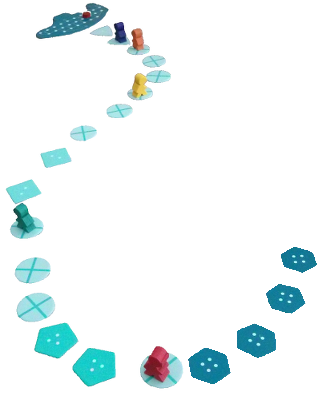
March, 2017
Americorp / Eurocorp

Moonbase Alpha is a two-player war game. I don't play a lot of war games but I couldn't resist this one because of its great art design. The game throws you into a future of corporate wars on the moon. But what it really does is throw back to the classic TV sci-fi of the 1970's. The designer notes his fondness for this genre, and Moonbase Alpha sure establishes his cred. The game's look and feel nails this theme. As a child of the 70's myself, who grew up watching Space 1999, UFO, and The Starlost, I dig this game.

The Luna Mining Corp and Mond Bergbau AG are competing to mine the moon. Of course, they're doing so with the help of Private Military Contractors. Each company's stock price is at stake. Battles won and lost effect public opinion back on Earth. Just like during the Vietnam War long ago, the hostilities between the two corporations are often televised which makes matters worse.
Vietnam in a vacuum? Well not really. The game has a more controlled feel. Like loping across the lunar surface clumsily in low gravity, the game is a slow, relentless tug of war that involves carefully positioning your units and TV cameras before blowing everything up with a bunch of dice rolls.
The rule-set for this lunar combat is small as war games go, but it's still written in the terse constitutional style of nested articles typical of war games. I thought I liked this style of rulebook. I appreciate precision in words, well defined terms, and the active process of unravelling dependancies between paragraphs.
Turns out I don't. A few inconsistencies in language, a few unexamined assumptions and rule-sets like this fall apart. While the rules for Moonbase Alpha are wonderfully structured and introduce the concepts of the game in a smooth and effortless way, some cog or other slips a tooth when I read them. Despite the clear attempts to be clear, several ambiguities in the text persist.
Heading over to the game's rules forum at BoardGameGeek.com confirmed I was not alone in my confusion. More importantly, from the designer's responses to questions there, I gleaned that another part of my problem with the rules might stem from my preference for Eurogames over American style games.
I haven't talked much about 'Ameritrash' games in these reviews (the only one I really play is Firefly: The Game [in the cupboard]) and now is not the time to start. For a good discussion of Ameritrash vs. Eurogames see boardgamegeek.com/wiki/page/Ameritrash#. Just know that, in general, Eurogames are streamlined, elegant, low-luck works of art and Ameritrash games are gaudy, boring dice orgies. <wink/>
Yes, yes. I know that war games aren't considered Ameritrash, but in my limited experience with both they do have something in common: complexity.
I like low complexity games, games with tiny rule-sets that yield deep gameplay such as Pandemic [in the cupboard] or Patchwork [cupboard].On the other hand, games with multiple phases and specialized units of all sorts and bezillions of little action cards and event cards and encounter cards that must be grokked anew each game because you've never seen that power before and likely will never see it again... HIGH complexity games drive me mad. They dress themselves up in detail but often offer few significant choices during play, a fact they disguise with all their bells and whistles... but I digress.
War games require moderate to high complexity to model the types of units and weapons, terrains and encounters they strive to simulate. That's fine, but this complexity can be slippery. All units fire and move, but each does so differently. If the rules codify movement, they must include exceptions for different units. If they codify unit behaviour, they must repeatedly detail rules for movement.
Writing clear rules is never easy. Overall, the rules for Moonbase Alpha are solid, they just need a little buff. Speaking of which...
Don't mistake me. I'm complaining here about a theoretical difficulty that besets the clear writing of rule sets, not about Moonbase Alpha. I really like Moonbase Alpha. It's engaging, fun and theme-y. And it comes in a small box!
July, 2017
Touched by the Goddess of Gaming
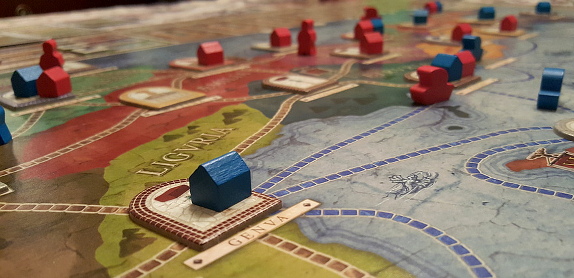
Ah, Concordia. Just saying her name excites and calms me. This game is smooth. It models the Pax Romana, a period of trade and prosperity in the Roman Empire when the Goddess of Peace was ascendant.
Players invest resources into enterprises in neighbouring cities and slowly expand their economic influence throughout the Empire. They trade resources at the forum. They buttonhole Provincial Governors to increase resource production. They make speeches in the Senate which endear them to the Gods. There are a plentiful number of possible actions in this game.
And this is the great innovation of Concordia. It takes the area control and resource management of The Settlers of Catan [sequel in the cupboard] and replaces that game's sometimes frustrating roll of dice with a deck of action cards.
Every player starts with the same deck, including a card that mimics the one last used by another player. On their turn, a player must decide which action remaining in their hand to execute. Another card in their deck allows them to pick up all of their cards previously played giving them access to those actions again. Still another card allows them to purchase new action cards to expand their deck. This is some freaky good game sh!t.
Action selection is one of my favourite game mechanics and Concordia perfects it. Strategies abound, but so do tactics. Because of the way choices quickly ramify through each player's action deck, things get tactical real quick.
Player interaction is high, in that indirect Eurogame-y way. For instance, paying attention to where other players are in their Produce/Trade/Build cycle is important in the race for resouces. But there are many ways to get what you need, and often, breaking your stride to snatch an important card or resource will benefit you more than board position, and it will keep your competitors guessing.
The game also sports lovely art, supports multiple player counts well, and plays relatively quickly. Early turns take longer, but a momentum soon kicks in.
There's a lot going on in this game, but it all meshes and flows. Concordia makes you feel like you're competing in an economy. Not in a dry, mathy way, but in a lively way: spotting opportunities and making them.
resources: The game has spawned many expansions/new maps. Most introduce slight rule changes to mix things up, although the Salsa (Latin for "salt") expansion adds some more serious bells and whistles: a wild resource, variable player powers and one-time-use powers. Here's a player aid that helps make sense of the expansions, and an updated player aid specific to Concordia: Salsa.
July, 2017
Sunny Ways

Cinque Terre: The Five Villages is a medium-weight pick-up-and-deliver game with a delightful theme: harvest brightly coloured vegetables from the steep hills of Liguria, Italia and deliver them to the grocers of the villages of sunny Cinque Terre (Cheen•kweh Terr•ehh).
This pick-up-and-deliver mechanic is trickier than it sounds. Your tiny three-wheeled delivery vehicle (which has more in common with a scooter than a truck) can carry only a few vegetables at a time. It also drives between the five villages in only one direction, clockwise. Are you in Corneglia (village number 3) and need to go back to Manarola (village 2)? Too bad. It's onward to Vernazza and Monterosso al Mare then back through the hills to Riomaggiore (village 1) first.
Your deliveries are mediated by order tickets. Olive (oh•lee•veh, olives) may be in demand at one village and arance (ah•rahn•cheh, oranges) in the next. Sometimes an order needs more veg than will fit in your truck. Round and round you go. Can you complete the order first? You can see that another player has already sold some of the items needed at those villages. The first player to fulfill the order completely will earn that ticket and its lire (lee•reh, victory points).
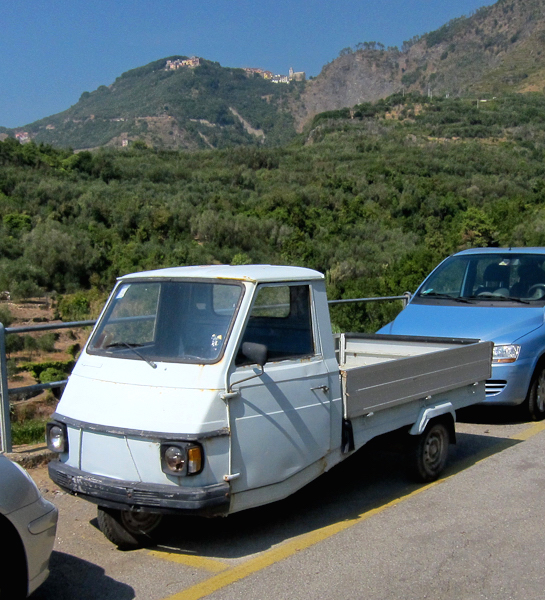
There are three hillsides along your circular route. They contain the eight terraced gardens that grow the produce you deliver. During the set-up of each game, the locations of the gardens are randomized. Sometimes grapes, garlic and zucchinis (uva, agli e zucchine) might grow on one hillside, and lemons, tomatoes and mushrooms (limoni, pomodori e funghi) on another. As one action you can harvest up to 4 fruits or vegetables (brightly coloured cubes) from a hillside if you have room for them in your truck. How efficient can you be? You don't need limoni (lee•moh•nee, lemons) right now, but you have a private order in your hand that will need un limone (oon lee•moh•neh, one lemon) eventually. Better pick one up now while you're loading pomodori (poh•moh•doh•ree).
During set-up, you also roll a bunch of brightly coloured dice and randomly assign them to the villages. They're coloured like the cubes and they set the prices vegetables fetch in each village. You earn points selling produce regardless of order tickets. If funghi (foon•gee) fetch five lire in Riomaggiore, selling 2 or 3 of them there can earn you as much as completing an order! Act fast though, there are only so many of each veg to harvest.
The last element of the game is set collection. To harvest produce you must discard brightly coloured cards you've collected with precious actions. Where are all the orange cards? Draw from the deck blind and you might get one. Or perhaps it's better to use your limited actions to harvest due (doo•ehh, two) olive with the two oliva cards you have, move and sell them.
Cinque Terre plays a lot like Ticket to Ride [in the cupboard] but with a little more mathiness. It's not quite as elegant as TTR (what is?), and sometimes games can become lopsided if the tickets drawn provide synergies that favour one player, but the game more than makes up for this with its rich theme. Just breaking out the board makes me feel happy. It's bright and colourful and makes me feel like I'm on vacation beside the sparkling Mediterranean. Board games are such a powerful medium/art form.
Strong gameplay and lively theme aside, the reason I appreciate Cinque Terre most is because of its bits. Cinque Terre is a board game's board game. It uses almost every possible piece of game hardware and uses them all well...
- Game board: gorgeous and in constant use maintaining the game state. It's also not too large which is important in my opinion, 'tableability' being an important, but often overlooked, part of good game design.
- Player pieces: wooden, chunky, cute, fun to drive around the board.
- Player boards: elegant, spatial; the data they track is easily visible from way across the table.
- Cubes: evocative, colourful; never have standard 8mm wooden game cubes embodied the things they seek to signify as gleefully and thoroughly as the coloured cubes in Cinque Terre do; picking up a red cube, yellow cube and purple cube — yup, i'm holding a ripe tomato, a firm lemon and a bunch of plump grapes.
- Dice: only rolled once but they do their random best; again, they're coloured to match the cubes, instantly speaking the language of the game and effortlessly imparting data vital to gameplay.
- Produce Cards: coloured (of course) and illustrated; they provide a language-independent key to the cubes, and teach Italian too.
- Order Cards: simple but laden with data; the vertical layout of the villages matches the geography of the coast, which of course matches the game board, and most importantly the player boards; holding several of these in your hand and comparing them to the mid-game state of your player board and to the public order cards on the game table can melt your brain.
As you can tell, I enjoy the bits and pieces of board gaming. They are why I no longer play video games. It's true that board games are more social, more educational, more strategic and more fun than video games. But it is in the tactile nature of playing them that board games really outpace their digital cousins.
And this is the triumph of the modern Eurogame: taking a mathematical problem, set in a strategic space, governed by thematic rules, managed by an array of variables, and distilling all that into a physical engine of play — colourful bits of wood and cardboard. Cinque Terre is one of these.
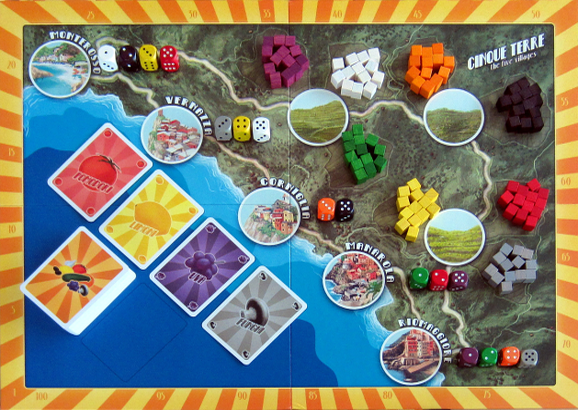
This is some invisible nonsense text that is hidden behind an image. It exists to provide a place to position and anchor link properly to allow the menu at the top of the page to jump correctly to the start of the next review.This is some invisible nonsense text that is hidden behind an image. It exists to provide a place to position and anchor link properly to allow the menu at the top of the page to jump correctly to the start of the next review.This is some invisible nonsense text that is hidden behind an image. It exists to provide a place to position and anchor link properly to allow the menu at the top of the page to jump correctly to the start of the next review.This is some invisible nonsense text that is hidden behind an image. It exists to provide a place to position and anchor link properly to allow the menu at the top of the page to jump correctly to the start of the next review.This is some invisible nonsense text that is hidden behind an image. It exists to provide a place to position and anchor link properly to allow the menu at the top of the page to jump correctly to the start of the next review. This is some invisible nonsense text that is hidden behind an image. This is some invisible nonsense text that is hidden behind an image. xxxxxxxxxxxxxxxxxxxxxxxxxxxxxxxxxxxxxxxxxxxxxxxxxx This is some invisible nonsense text that is hidden behind an image. It exists to provide a place to position and anchor link properly to allow the menu at the top of the page to jump correctly to the start of the next review.
July, 2017

A Tidy Little Production
Garbage Day is a wonderfully juvenile dexterity game in which players try to get rid of cards depicting trash by piling them on top of the little plastic garbage can that the game is packaged in.
This isn't like building a house of cards however. Each card has two holes at its top corners. You must be able to see through these holes after a card has been placed. Gradually the garbage on the can splays out into a broader and broader circular fan of cards. Carefully placed, the cards tend to brace themselves. Until of course they don't. The pile of garbage can get preposterously large. It can appear to be about to topple, groan under its own weight, shift, and then hold. When it finally falls, the room always fills with a cheer.
This is fun. What is even more fun is the thorough premise of the game. You all are college roommates. No one wants to take out the garbage. In fact, the communal sloth of youth has become a competition in your house. Not only do you overfill the garbage can, to prevent catastrophic overflow you also stash trash under your bed. And under your roommates' beds too! When the garbage can spills, if you caused the cascade, you're (usually) out of the game. The last person remaining in the game relaxes while they watch their roommates clean up the house and take out the garbage.
The designer of Garbage Day worked hard to make sure there's a little game to this game. The garbage cards sport points. You can have only so much garbage in your room before you must pile it all on the can. Some cards can only be placed in your room, some only in the garbage, and some give you a choice. As mentioned, some cards can be placed in other people's rooms. Sneaking into a roommate's room to hide "Spoiled Milk," "Last Week's Noodles" or "Month-old Pizza Box" causes much delight and mock resentment at our game table.
Even better is stopping by another's room to leave a "Smell." These silent but deadly cards don't raise the messiness score of their room thereby edging them closer to having to clean it up, but when that clean up day comes, Smells add to the number of cards they must balance on the pile of mess in the centre of the game table.
Garbage Day is a quick, light little game that is especially rowdy if anyone in your group likes fart jokes, and who doesn't?
August, 2017
Play the Player
Cockroach Poker is the ultimate bluffing game. There are lots of good bluffing games, Coup [sequel in the cupboard] and The Resistance [in the cupboard] top among them. But Cockroach Poker is pure. Bluffing is all it's got.¹ No variable powers, no deductive triangulation, just, "This is a spider. Do you believe me or not?"

Cockroach Poker is a compact card game. The Cockroach Poker deck has 64 cards in 8 pesky suits. All are shuffled and dealt between from 3 to 6 players. The aim of the game is to pass off all your pests to the others at the table without collecting too many that they pass you.
When a card is passed, the passer announces its suit. This being a bluffing game, they need not be telling the truth. It's up to the recipient to call the passer's bluff or look at the card themselves if they daren't and then pass the card on to someone who hasn't yet seen it. If a card makes it's way, this way and that, around the table to the last person possible, they must call it. "Yes, the person who passed me this is telling the truth, it IS a spider!" or, "No, you're lying you lying liar pants on fire."
If a caller guesses right, the person who passed them the card must put it face up in front of themselves. Otherwise the caller adds it to their entomological tableau. The first person to collect four of a kind loses. There is no winner, just a lousy loser.
Once a person collects two or three of a kind, the game really starts. How to feed them a fatal final card? Give one to them directly and truthfully because you have the reputation for being false? Lie, because you're typically a straight shooter? Or follow this logic but pass the card to someone who's sure to pass it to the wounded antelope? This basketball-like subterfuge is my favourite. Of course, the recipient knows all of this, and may simply employ a classic Vizzinian² double- triple- or quadruple-think.
I prefer the original version of the game over its sequel, Kakerlakenpoker Royal. The sequel adds all sorts of brocade: wildcards, null cards, trump cards of a sort. These reportedly enhance the bluffing but you know me, I'm a purist. Why mess with a simple beauty? I also prefer the artwork of the first game — which is beautiful (in both games).³
Cockroach Poker is a boisterous closer which plays better the later it is and the tired-er you all are.
¹ Ya ya, bluffing is all Liar's Dice and Skull & Roses have too, but neither of these are in rotation in our game group.
² You will remember Vizzini, the Sicilian spymaster, if you've ever seen The Princess Bride.
³ Do I ever acquire a game with less than beautiful art? Oh yeah, Kingdom Builder [in the cupboard].
August, 2017
Divine Point Salad

Many European board games are structured so that players may gain victory points in a variety of ways. Their boards are peppered with different tracks and areas where player markers rise and fall during scoring cycles. The most extreme examples of these designs have been named "point salad." (Anyone who's played one of popular designer Stefan Feld's games such as The Castles of Burgundy [in the cupboard] is familiar with this genre of game.)
De Vulgari Eloquentia by Mario Papini (2010, 2-5 players) is a divine example of point salad gaming.
'De Vulgari Eloquentia' (On Eloquence in the Vernacular) is a Latin essay written by Dante around 1303 A.D. at the very beginning of the Italian/European Renaissance. From the game's rulebook:
Italy, late Middle Ages. The fabric merchants need to write down their contracts in a language that everyone can understand and the literates are looking for an alternative to the elite of the traditional Latin language. So, the Volgare, the language spoken by the common people, taken from the dialects spoken in the various Italian regions, starts to gain relevance.
During this period, Francesco D'Assisi writes his famous Canticle of the Sun and Dante writes the Divine Comedy – both written in Volgare.
The players will have to do their part in the creation of this new language! But who will provide them the proper knowledge to understand the manuscripts in the different dialects? Who will succeed to uncover the secrets of the books inside the Papal Library? Who will embrace the religious life and who will remain a merchant? Some of the players can become a famous banker, someone else can climb the church's hierarchy to be the next Pope! But in the end, who will be the most appreciated and respected for his status and his culture?
The aim of the game is to obtain the most victory points, also called Volgare Points or simply VP. The players will gain VP from reading manuscripts, looking for important documents like the Canticle of the Sun or the Riddle from Verona...
This game is a thematic triumph. It creates a sense of place and purpose and just-plain-being-there better than any other game I've played. It's also fun to play. I'll attempt to summarize it using my typical broad strokes, but the only real way to understand this game's magnificence is to play it. (I guess that's true of all games. I do tend to overestimate my descriptive powers.)
In De Vulgari Eloquentia, you have a number of actions each turn which you use to earn money, increase your knowledge, patronize abbesses and nobles, move about medieval Italy and depending on your location, research manuscripts, pursue rare documents, and promote your character. Most of these actions accrue either: victory points; position on a track vying for victory points; or resources which are used during the game's final scoring for... victory points.
You navigate the countryside as a merchant but you may join a religious order at select locations. This hampers your future earnings but grants you a bonus or special power. Later, at other locations and with enough money, you may even become a Cardinal. Cardinals have super-special powers. During final scoring (with enough resources), you may elevate yourself one last time to the status of banker, monk, Camerlengo (a Papal Chamberlain) or even Pope! You guessed right: the Pope earns more victory points than a monk.
A randomized event (worth money and knowledge) occurs somewhere in Italy at the start of each round of play. Players can see these in advance and plan their peregrinations accordingly. One of the research tracks can only be invested in on certain turns in certain locations.
All of these point goals pull you in different directions but they remain strangely unified by the game's map of North, South and Central Italy.
Movement in the game is slow and relatively expensive. All of the opportunities sprinkled around the map make it very purposeful. Playing this game really makes you feel like Dante himself, in exile, roaming Italy from region to region, listening, learning, laying the foundations in your mind for a great poem in the vernacular.
To use today's vernacular, that's cool daddy-o, cool.
resource: Scoring is elaborate in De Vulgari Eloquentia. There's a lot to do, lots to count, a lot to remember. To help with that I came up with this tally sheet. It can also help you plan your game by reminding you of how exactly the game's varied goals work.
August, 2017
Challenge and Response
Civilization. Now there's a good theme for a board game. Human development from the Stone Age to the Space Age. Invention, exploration, monument building! Culture, military adventure, empire building!
There have been many civilization themed board games. I've played two of them¹, Sid Meier's Civilization: The Board Game and Historia. I quite like Historia.
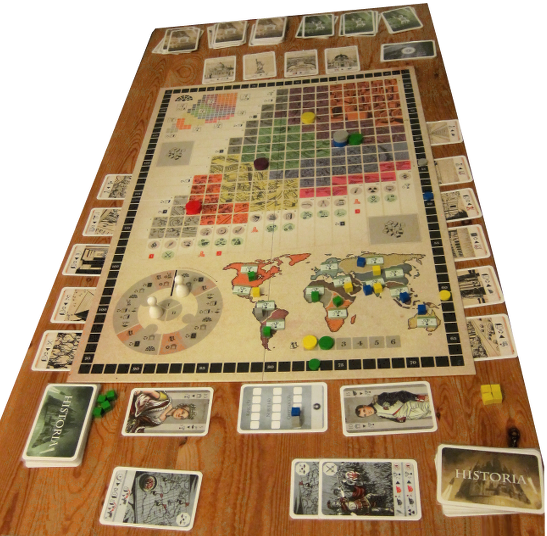
Historia wraps up all the trappings of a civ in a tight Euro. For a Eurogame it encourages a high level of player interaction. A brutal abstraction makes it tick.
For example, instead of flipping tiles to explore a world detailed with rivers and forests and deserts, players place cubes on a tiny map of the world. Cubes are expensive. (They represent all of your civilization's resources and at the start of the game you have very few. They power most of your actions. Recycling them back into your economy is an important task in the game.) For this reason, expansion across the game's tiny map is slow.
Interestingly, this scaling of time somehow makes the tiny map seem bigger. There, in schematic form, is the whole world and, as the game progresses, your slow march to conquer it. I really like this view from 30,000 ft. It declutters and cuts to the chase: neighbours, targets, threats.
The second thing the game streamlines is technology. Instead of myriad tech cards that stack into a more or less useful pyramid of powers depending on your ability to process all the recombinant choices of the entire tech deck at once... instead of building a personal tech pyramid, players all navigate the same Tech Track. This is the great river of progress, from fire to Internet. One thing follows the next, each granting wonderful new powers.
Too simple? Not really, because this Track is integrated with another one representing Military power. These two Tracks operate on opposing axes (horizontal and vertical). Together they form a grid which players zig and zag up and across, increasing their technical skills when it suits them, and at other times increasing their military might. The actions to advance one way or the other are independent of each other, so choices must be made. Players navigate the grid in different directions and at different speeds depending on their game goals.
What's more, this grid space also represents the various timbres of civilization: empire, republic, feudal state, etc. The grid is divided into zones which, again, players move through in an order they choose as they play. Different zones confer different benefits. Ah, the joy of a rough mathematical model. Player marker, meet Arnold J. Toynbee—famous 20th century historian of civilization. Will you grow your civilization into a high tech, low power utopia? Or a belligerent gang of illiterate, spear chucking barbarians who've yet to discover gunpowder and moveable type?
Play proceeds by simultaneous action selection rather than phased actions. Similar to Concordia [in the cupboard] players have a small deck of action cards from which they choose their next action(s). This hand of cards becomes slowly exhausted until one or more players at the table play their Revolution card. Unlike Concordia's 'refresh' card which allows a player to collect all of their played cards back into their hand, a Revolution allows all players to collect only the bottom two cards of their discard pile back into their hands. Tricky. Cards/actions can get buried in your discard pile. Hand management (like cube management) is crucial in Historia.
Why doesn't everyone just revolt early and revolt often? Because a Revolution also advances the game clock. The game winds through three ages each consisting of four turns. How many action rounds players get on any given turn varies depending on the frequency of Revolution. There are so many things to do in Historia. No one wants to accelerate the game. Except they do. Players who revolt get one additional card, a card of their choice, returned to their hand! This is Very Tricky. The unpredictable rhythm of Revolutions adds a great layer to the game. All players must take care the carpet isn't pulled out from under them. I do love a good carpet pull... when I'm the one pulling.
My last favourite part of this game is how it handles battle. No dice, no unit cards, no production cycle of plastic. A territory may hold only one cube per player. Territories are worth points. Need to vanquish a squatter? Play your War card. The player higher on the Military Track wins.
Here is a system I love. I know that games that granulate battle in a finer way than this, say with multiple dice rolls, are fun and that with good planning combatants can protect themselves with many dice and that many rolls average out. But I resent the Odds Gods. As I recall, they've never done me any favours (my glass is always half empty too).
Historia's system is transparent and in full player control. And it's not as simple as it sounds because turn order can mess with your plans. A player may see an attack coming and increase their Military level to equal yours. Remember, in Historia players select and reveal their actions at the same time. Your War action may be wasted if Military levels change before you get resolve it.
Sure, this can encourage an arms race. But what battle system doesn't? Point rewards in Historia are well balanced. It is entirely possible to win the game without pursuing Military points. Also, there is no player elimination in the game. A player may never lose their last cube on the map. I really like this. Warfare is a part of the game, but doesn't dominate it.
Historia is a long game, especially with a full player count. It plays 6, which is nice for game days that gather lots of friends. It plays just as well at all player counts (1-6) because of a clever Civbots mechanism - automated players who take random, programmed actions at the end of each turn. Because many actions depend on having geographical neighbours, we always play with Civbots. Their actions can be a bit confusing to execute sometimes. This programmatic player aid may help you with that.
This was a long review. Can you tell I like this game? I apologize for giving away a few of the game's strategic dynamics. It's always delicious to discover these yourself during play, but these dynamics are what draw me to Eurogames. They make play taut which, for me, is so refreshing compared to other styles of games.
¹ This is a fib. I've also played Through the Ages, Nations and Clash of Cultures, and quite enjoyed them too. But I haven't played them enough to contrast them with Historia at this time — although, if pushed, I'd still rate Historia as my fave civ. I've also played Guns and Steel and The Flow of History in my head... which isn't really like playing them at all, so I can't really venture opinions about those games either. I have never played Antiquity, Civilization, Advanced Civilization or Mega Civilization and probably never will. I would like to try playing The Golden Ages.
October, 2017
Yes Yes


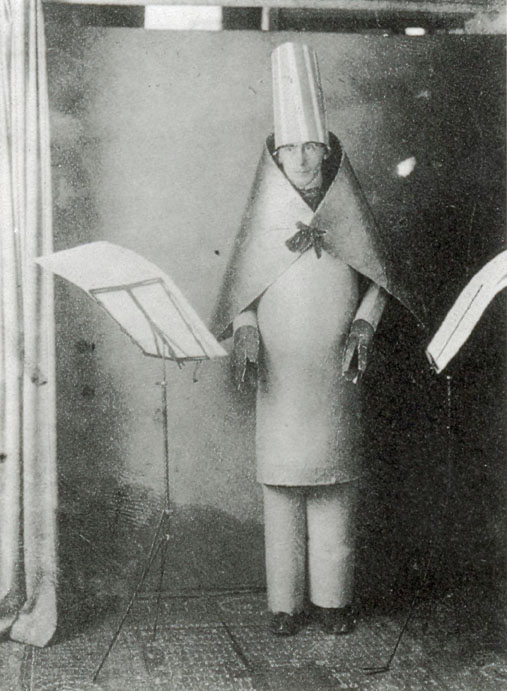

"De Zayas! De Zayas! Je suis venu sur les rivages du Pont-Euxin", photogravure. Francis Picabia, 1915.
Hugo Ball reading "Karawane" at Cabaret Voltaire. Unknown photograph-er, 1916.
"1 of Aerialists", collage. Franz Vohwinkel, Heiko Günther, Yusuke Mamada, 2016.
"Karawane", sound poem. Hugo Ball, 1917.
Do you like Rummy? Canasta? Gin? In 1998, prolific game designer Reiner Knizia created a deft card game of making melds called Circus Flohcati (2-5 players).
It uses a custom deck of 10 coloured suits each modelled after a class of circus performers: yellow Strongmen, orange Lion Tamers, red Aerialists. Each suit has 8 ranks, numbered 0-7. And each card is labeled with an unctuous adjectival phrase... the 0 of Contortionists is: A Most Flexible Contortionist. 3 of Acrobats: An Almost Insanely Undaunted Acrobat. 2 of Sideshows: An Astonishingly Dull Sideshow.
To go out, you must perform a Gala Show (collect one of each suit). Easy perhaps, but this meld scores based on the ranks you've collected, so there's incentive to fish for the 6's and 7's of each suit. While you mine the deck, you can lay down Trio Acts (sets of 3 cards of the same value) for points. Here you can use cards not useful to your Gala, or starve your Gala a little to complete a Trio. The game also incorporates a push-your-luck mechanic as you reveal cards from the deck for you and following players to choose from: pull a suit that's already exposed and you lose your turn. To mix things up further there are a few cards in the deck that let you steal cards from others, etc. Circus Flohcati is a very well designed little game.
Do you like Surrealism? Late 19th century kitsch? Old-timey typography? In 2016, Grail Games published a new edition of Circus Flohcati with great new artwork. Long out of print, this new edition was designed to re-introduce the game to an adult audience.
Earlier editions directed the game toward children with cute illustrations of a tiny flea circus. This one does not. The characters that illustrate this edition are collages of photographs of old-fashioned circus performers and anatomically detailed engravings of fleas. Heads of the latter pasted on the bodies of the former.
That's right. People with giant flea heads. Some find the art creepy, but I find it perfectly charming. Then again, I was a Cultural Studies major who made 8mm films and mixed-tapes of punk rock music instead of writing essays for courses like "Phenomenology & Existentialism," and "The Avant Garde." As I learned in that last course, Grail's Circus Flohcati is actually more Dada than Surrealist. (Let it not be said my undergraduate studies were a waste of time!)
Dada was an international art movement focused on nonsense and subversion. It was formed in Zurich in 1916 as a reaction to the horror of WW I. It rejected rationalism — the capitalist world order that the Dadaists saw as the cause of the war. It did so with painting, collage, graphic design, sound poetry, gatherings, sculpture, found art. It was anti-art, strove not to become a movement, and was short lived. Nonetheless, it laid the ground work for Surrealism, abstract art and Postmodernism. One of the most recognizable pieces of modern art, Fountain (a urinal with an artist's signature. Marcel Duchamp, 1917), is Dada.
People with giant flea heads. Dada.
The release of this edition of Circus Flohcati is a striking work of art in its own right. It plays great too.
November, 2017

Math. Under the hood, all games are just math. It's the rare person that loves math. Those who do, go to work at CERN or join the poker circuit. The rest of us play board games — board games that carefully hide their math under layers of art and theme.
Some board games, however, dare to expose more of their math than others. This can be a risky move. If the game is thin, exposing its math could flatten it further revealing its simplicity or worse, revealing a solution to it. Any game more complicated than Tic-Tac-Toe won't likely have an actual solution, but even a dominant strategy, once revealed, will break a game and suck all play joy from it.
For these reasons (stigma and the pain of intimacy) I get excited by games like Patchwork that are brave enough to wear their math on their sleeve.
Patchwork is a simple puzzle, if you call several overlapping multi-dimensional matrices simple!
The goal of the game is to collect and assemble a large number of Tetris-like pieces in order to cover your small game board as completely as possible. Each player is sewing their own quilt. Best not make one containing too many holes or you will loose points.
Each turn, you go shopping for scraps of fabric from among a few randomly shaped pieces. These are colourful cardboard pieces shaped like T's and L's and H's and other blocky things not found in the alphabet. Each piece has two costs: time and buttons. As you play, you travel a time track. Some pieces take longer to stitch into your quilt than others. Add too many of them and you'll have fewer turns in a game.
Advancing along the time track isn't bad, however, because that's how you earn buttons. Button income is paid at certain spots along the track depending on the number of buttons sewn into your quilt. Here is another dimension of the game: some fabric pieces sport one, two or three buttons making them important income sources if added to your quilt.
Did I mention that buttons in hand at the end of the game determine the winner? The math astounds. How much of your quilt will a piece complete? Will it fit into your quilt? Will it make future pieces hard to place? Will the piece earn you buttons? Enough to offset its cost? Do you have the buttons saved up to buy the piece (ideal pieces can be expensive)? Can you afford the time that a piece costs (ideal pieces can be expensive this way too)? Will the piece push you far enough down the time track to earn you buttons this turn? Or to earn you a handy single-square patch (a few of these are sprinkled along the time track!)?
And don’t get me started on turn order. The time track determines that too because your turn ends only after your marker leaps ahead of your opponent’s. That’s right, if they buy a time-expensive piece and race down the track, you might be able to buy two or three time-cheap pieces in a row!
All these parameters float right in front of you on the surface of the game. Costs, geometry, timing... How the designer determined the characteristics of each piece/shape boggles my mind. Because the game is very balanced. For something so simple it’s truly intricate. It plays as tight or loose as you like. I find it the perfect length, longer than a filler but short enough to squeeze into a stray hour of the day. Patchwork’s only weakness is that it supports two players only. Attempting to balance the game for more players must have been too much for the supercomputers at CERN.
November, 2017
Nice Dice
Let me tell you a story. I was sitting on my patio last summer and my whole life flashed before my eyes...

I remembered my Childhood Bicycle being stolen. It was an early bit of Bad Luck and I blame it for making me a cautious man. I’m still in Psychotherapy over the event.
On the up side, that turn of fate also got me into Fitness Training. Without a bike, I became a Marathon Runner and later in life I got into Nordic Walking. In fact, looking back on it, Health became the focus of my life.
I never pursued a career. I took a Job at Dad’s Company instead. It gave me enough money to buy an Apartment from a Friend and some Life Insurance —remember, I was a cautious man. Working for dad wasn’t that much fun, but a Trip around the World fixed that.
Instead of concentrating on work, I was an Activist. At first, I did Volunteer Work on behalf of my Friends from the Orchestra. I lobbied for more tubas and trombones. Later, I became concerned for the welfare of unwanted cardboard and started a Boardgame Club.
However, my greatest triumph came in Middle Age with the birth of my Twins. Raising them wasn’t cheap but they brought so much Good Luck to my life.
By the end of my life, I had expanded Dad’s business by buying a Factory and I even splurged on a Sports Car. Who needs a bike anyway?
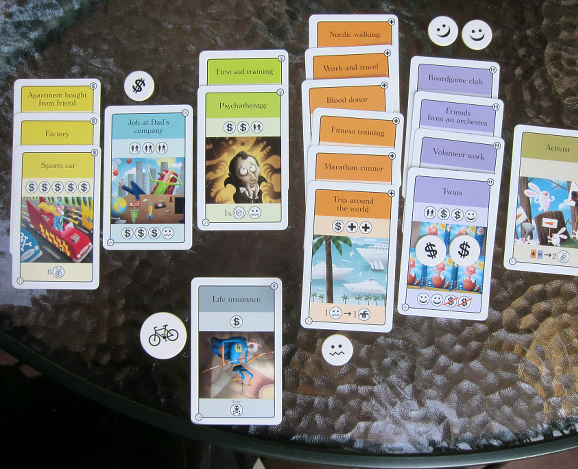
CV is a fun and funny board game about the stages of life. Players build a tableau of cards that represent education, relationships, jobs, possessions and the like. Sets of cards earn you points. Each card has a cost of one or more symbols which exist on a set of dice: first aid Crosses for Health, Dollar signs for Money, light Bulbs for Knowledge, Couples for Relationship, Frowns for Bad Luck, and Smiles for Good Luck. Each card also pays out in these symbols or various other special powers.
For example, 'A Job at Dad’s Company' requires you roll three Couples. Once it’s in your tableau, it gives you three Dollars and a Frown. On your next turn, you can use one of those Dollars along with two Crosses to buy 'Trip around the World' (if available). 'Trip' works well with 'Job' because once a turn it can turn a Frown into any other symbol (except a Smile). Interactions between cards like this are the heart of the game.
Five cards are available for purchase each turn. They scroll along during the game (oldest card discarded) and are replenished from three successive decks of cards: first the Early Adulthood deck, then the Middle Age deck, and finally the Old Age deck. The costs and benefits of cards escalate from one deck to the next. As you build your tableau, you build a loose engine of symbols and abilities that helps you acquire more expensive cards.
The relationships between the cards (their names and types) and their symbols/abilities are highly thematic. Returning to our example: a heavy reliance on relationship is what gets you hired by your dad, and working at his company has its downside. World travel, on the other hand, can give you the perspective to turn frowns upside down. These thematics knit together your tableau. At the end of the game you’ve built more than just a curriculum vitae, you’ve got a detailed life story.
As much as I appreciate this part of CV (you know I value integrated storytelling above all other things in game design), the thing I like best about CV is its dice mechanic. Just like King of Tokyo [in the cupboard] CV stands on the shoulders of Yahtzee. You roll a number of dice multiple times, keeping or re-rolling some of those rolls in order to secure the symbols you desire.
This is a nice mechanic. Nice dice. Nice. As nice as dice get for me. Re-rolls give you a sense of control over the ivory monsters’ caprice. But what is really nice about this mechanic is how it models the vicissitudes of life. The mercurial nature of dice, that thing I have such trouble making peace with in most games, really works in CV. Life is long and takes strange turns. You can’t always get what you want.*
Some people complain that CV loses its shine because its cards quickly become familiar. All of the cards are revealed each game. My partner and I don't find this a problem. There is so much variety in the game, the cards flow past your turns so quickly and unpredictably, that you don't get a crack at the same cards every game. Each game of CV feels fresh and the stories it generates, new.**
The only criticism we have of the game is that it ends abruptly. The end of the game is determined by the number of cards remaining in the final deck which is hard to see coming. A quirk of the game's design is that the row of cards for purchase, around which you are building your final life plans, suddenly becomes unavailable when the end-of-game hammer drops. The normal rhythm of the game can trick you into thinking you will have another turn, when you do not. This can feel arbitrary and mean, and it takes playing several games to learn how to work with this end-game hiccup. This is a minor quibble, however. The humour and charm of CV more than makes up for it.
* But you if you try sometime, you just might find, the points that you need.
** At the end of a game, we often take a moment (after tallying points, of course) to each make a little story out of our tableaux like I did above!
November, 2017
Go with the Flow
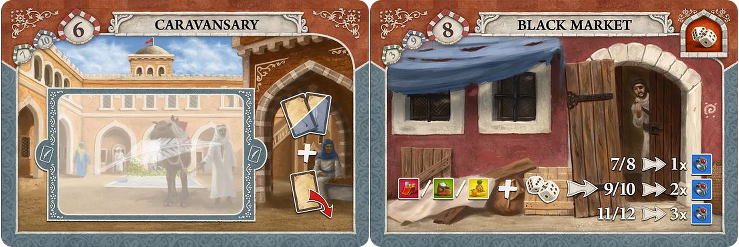
How many perfect games can those Germans design? Istanbul, by Rüdiger Dorn, is another Eurogame that hits the sweet spot for me, my partner and our game group: medium in weight, low in rules-complexity, shorter in length, elegant mechanically, quick to play, rich in strategic choice, fulsome in theme.
The game board represents the Grand Bazaar in Istanbul at the height of the Ottoman Empire in the 17th century, a grand grid containing shops and mosques, fountains and caravanserais. At this time it was the hub of Mediterranean trade, and it was not yet covered like it is currently. Today the Grand Bazaar is the world’s most-visited tourist attraction. It was and is one the world’s liveliest places.
Istanbul lets you get lost in this colourful, busy, distracting place by moving your player piece between sixteen locations in the bazaar. Moving is difficult in this crowded space, however. You may only amble to stalls adjacent to, or next to adjacent to, you. If a location is already occupied by another player’s Merchant, you must pay valuable Lira to visit it. And, you may only move if helped by an Assistant.
You have four Assistants. They travel with you until you use one of them to enter a location. There you drop one off and do whatever business that location offers. Your Assistants are disks the same diameter as your Merchant disk. By stacking these pieces you can pick them all up at once and drop the bottom Assistant as you arrive at a shop. Très élégant. (Sehr gut!)
As you move, you leave a trail of Assistants. Gradually your cadre dwindles. Your supply of Assistants effectively acts as a leash on your movement. Luckily, you may pick up an Assistant of yours, if you visit a location containing one. It rejoins your stack renewing your range. This is a game of circles, of doubling back. You must plan your route between actions carefully.
Each location in the bazaar offers different actions. Warehouses and Markets offer Goods, Lira in exchange for Goods, or Rubies in exchange for Goods or Lira; the Tea House and the Black Market let you gamble for Lira or Goods; Mosques offer special powers to make your shopping easier... there’s a lot of choice. Your ultimate goal is to collect Rubies. As you can tell, there are many ways to get them.
But the heart of the game is movement, how to chain together locations more efficiently than other players. Because for every game, the layout of the bazaar is different! The rectangular location tiles that make up the board are randomized during set up. A strategy based on buying Rubies with Lira that works in one game may not in the next. Locations key to this or that kind of transaction may be conveniently located in one game but not another.
Strangely, trying to decipher the layout of a particular board at the beginning of a game does not overwhelm. The chaos and personableness of the bazaar encourage you to find a good circle or two and just dive into the game. Once started, the constraints on movement and the necessity to circle efficiently keep your choices of next destinations under control. The game helps you plan. Major forks in the road are possible but because they are expensive (in terms of a less efficient turn) they crop up infrequently.
Best of all, because of the go-with-the-flow ethos that Istanbul possesses, turns are quick! Even at the full player count of five, getting up from the table to refresh your drink is risky. “Jim! It’s your turn!”
note on iconography and expansions: Despite my claim that Istanbul is a low complexity game, it actually possesses lots of fiddly bits. While the basic mechanics of the game are simple, the actions triggered by certain locations are unique, involved and easily forgotten between games. Like most modern board games Istanbul deploys a range of symbols on its boards and cards to jog players’ memories. By and large this iconography is clear once you learn it.
The reason I mention this is because Istanbul has spawned two lovely expansions that expand the size of the bazaar and layer new goods and actions onto the game. We enjoy the Mocha & Baksheesh expansion which adds a new and fancy resource to the game, coffee. Sadly, the expansion does not include all the replacement components necessary to update the original iconography of the game. This is a problem.
For instance, the game’s player boards contain a Ruby track that is marked to remind players to collect five Rubies in order to trigger the end of the game OR six Rubies in a two-player game. This is awesome for my little brain. In an iconography heavy game like Istanbul, I know where to look to remind myself how the game plays. How many Rubies do we need? Glances at player board. Right, five. Better get my ass in gear. Susan already has four.
However, when playing Mocha & Baksheesh, play continues to six Rubies regardless of player count. A little coffee icon added to each player board to indicate this would really help our game group since we break out the game infrequently and alternate playing with and without the expansion.
July, 2018
Patience and the Art of Game Development

I have a confession to make. I’ve never played Dominion, the game that introduced deck building, a mechanic so compelling that it spawned over a dozen expansions which for years helped Dominion hold dominion over its corner of board gaming. I've bumped into its big blue box many times. Never opened it.
The funny thing about this hobby is there’s just too much of it. Too many games. Even too many classics. One person just can’t get through them all. And they keep making more!
Depending on when you catch the board game bug, when you enter the hobby, you’ll be exposed to a whole different ecosystem of games. This is because the state of the art evolves. New titles do more or less the same thing as old ones, usually better, always with fancier artwork. Old games fall out of print, new ones take their place.
Of course, the classics get re-prints. Most gamers will run into them in time, or even seek them out. But sometimes a classic just passes you by. So it has been with me and Dominion, the granddaddy of deck building.
Deck building is a game mechanic where all players in a game start with a small identical deck of cards that offer the basic actions of that game. Over the course of the game they may buy cards to add to their deck. Players’ decks grow and diverge in nature depending on the types of cards they add.
During their turn, a player draws a hand of cards from their deck to use and discard. When their deck runs out, they shuffle their discards to re-form their deck. In this way the actions of their deck cycle randomly through their hand. As more powerful cards are added to their deck, they become available, but as their deck grows, they become available less predictably. Often it’s important not to buy too many cards, or to use actions (which are typically rare) to thin your deck, to permanently remove cards from it.
Lots of games employ deck building. Dominion is deck building all day. It consists of card play only. Games like Legendary make card play more intricate and thematic by adding multiple decks that introduce events and enemies. The recent Dune Imperium layers worker placement on top of a deck building engine. And The Quest for El Dorado uses deck building to power a truly glorious race game.
In The Quest for El Dorado, players navigate early 20th century explorers through a jungle of hexagons. Their meeples move through jungle using machete cards, cross rivers using paddle cards, and enter native villages with coin cards.

Coins are also used to buy new cards for your deck. The market of new cards offers all kinds of upgrades. Scouts offer two machetes of movement instead of the Explorer card’s one. Trailblazers, three! The market contains other marvels too: Compasses, Cartographers, Radio Transmitters, Millionaires!
But levelling up your deck takes time. Some of these cards cost four or five coins! When you’re lucky enough to get two Travellers in your hand at the same time (one coin each) you might buy a Photographer. She costs two coins and gives you two coins to spend. But purchased cards go into your discard pile, so you’ll have to wait for a shuffle to use them. This sounds like slow going, but turns are fast, and the game offers lots of them.
The maps for Quest are made of large tiles of many hexes. Some are more jungly, some more watery, some more full of impassible sections of mountain. The tiles can be flipped, rotated and recombined in many ways to create longer and shorter, easier and harder maps.
So far, the game sounds boringly straightforward. Ready, set, go. First one to El Dorado wins. But there’s a lot of jungle and such between the starting line and the golden city, and the math of movement can make progress difficult.
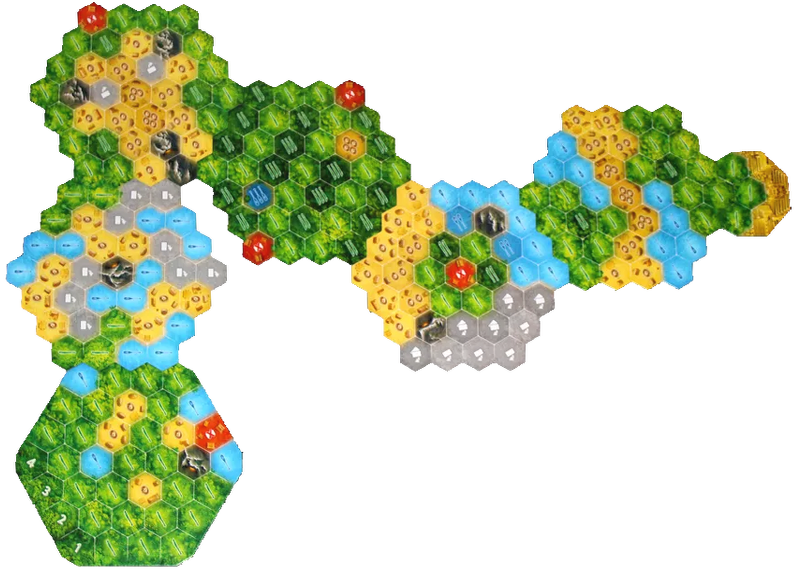
Hexes come in flavours (jungle, river, village) AND in strengths (one to four). To enter a hex you must play a card of the right type and sufficient strength, for example, to enter a four coin village you’ll need a Millionaire. A good map will create short paths through expensive terrain, and long paths through cheap hexes.
But the real crux of the game, its delightful frustrations and rhythm, depends on the particular cards you draw into your hand on a turn. You many need a big machete and some gold to zip though a shortcut, but draw paddles and gold instead. Time to plan another route. Or to stay put and use that gold to buy a new card. Or to move sideways to block an opponent, knowing that you’re likely to draw your big machete next turn and want to avoid being blocked yourself.
The combination of race mechanics and deck building, like gin and tonic, elevate each other into something unexpected and sublime. Who would have guessed these ingredients would complement each other so? (Reiner Knizia, the game’s designer, that’s who.) It’s not just the rich decision space that the one adds to the other. It’s also the physicality of picking a route and moving your meeple. This enlivens the card play, brings it into three dimensions, gives it a concrete purpose which is so much richer than the accumulation of victory points.
The game is self-balancing. If someone races ahead, everyone else adjusts their strategy accordingly. Games are almost always close. The final turns are always exciting. It plays well at all player counts and skill levels.
The Quest for El Dorado isn’t the reason I’ve never played Dominion, but it is the reason I probably never will. El Dorado does everything that a great deck-builder should and I’m kind of grateful that I didn’t fill the deck building niche in our game collection until it came along.
March, 2022
A Tale of Two Worlds
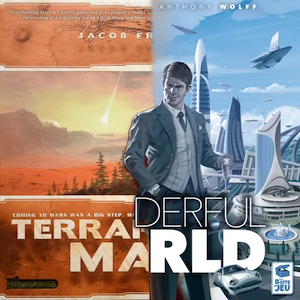
Imagine a heavy Eurogame. An engine-builder with lots of cubes and a fat stack of cards. Cards that, carefully played, create complex synergies of resource production, victory points, and award multipliers for those points. Each card has a thematic name and illustration, and represents a transformative technology, futuristic facility, or powerful government agency. By the end of the game you’ve amassed a huge tableau of cards that signifies your power block’s path to planetary dominance.
If you play games like this, you’re probably picturing the massively popular Terraforming Mars. It’s a great game that includes all of these elements and more.
But what if I told you to keep imagining? Imagine a game with all this AND simple iconography. And beautiful artwork. And streamlined play, faster set-up, and shorter play times.
In that case, you’d have to picture It’s a Wonderful World.
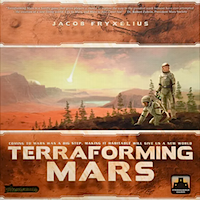
As you might imagine, Terraforming Mars is set on Mars where players compete for victory by terraforming the planet.
Players act as mega-corporations, each with a specialization.
They build grand economies made of cards representing terraforming tech, urban developments, agricultural infrastructure, and marauding asteroids.
Cards cost mega-credits to build and some have complicated pre-requisites. They award all kinds of things: points, special powers, emplacements, and increased production.
Player boards track the production levels of a number of resources like steel, energy, megacredits, and trees. These levels are bumped by cards as they’re played into your tableau. Production happens at the start of each round. Cubes of different types accumulate on your board until you spend them to buy more cards and to place cities, forests or oceans on the main board of the game, i.e. on Mars itself.
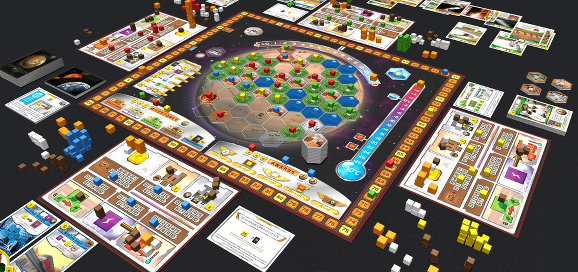
Gradually, Mars turns green and blue. Oxygen levels rise, and the planet warms, measures which are tracked and act as the game clock. Lots of actions in the game earn victory points, and many cards multiply them. A race for a number of awards also earns points.
It’s an intricate game of many interlocking parts (and many game pieces). Countless synergies between cards emerge from play, which is good because the deck is so large you can’t count on seeing a particular card in any given game. Constant adaptation to the cards you’re dealt is necessary. The game is like a wonderful jigsaw puzzle of fitting cards together, playing the odds that if you invest in a strategic direction, you’ll see just enough cards of the right type (and have enough resources to build them) to push up the terraforming track to victory.
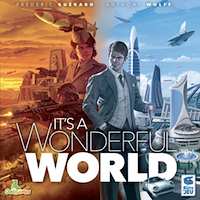
It’s a Wonderful World is set on Earth in a triumphal near-future. It sports a simpler but intriguing resource mechanic.
Players compete for victory as continental power blocks.
They build grand economies made of cards representing industrial infrastructure, military materiel, scientific facilities, and exotic marvels.
All of these items are illustrated with beautiful artwork peppered with a cheeky optimism and pop culture references. A common complaint about Mars is that its artwork is a bit generic and uneven. Not so in a Wonderful World.
In this world, over four rounds, players draft cards to spend as resources or to build in order to produce future resources and/or victory points. Each card costs certain resources to build; more valuable cards require more resources and/or rarer ones. Building and production happens at the end of each round.
The unique and tricky part is that production proceeds in a set order. Player’s first check their tableau for cards that make concrete. Any precious grey cubes they make, they may allocate to cards they’re in the process of building, if those cards require the grey stuff. Then everyone produces and allocates black oil; then green nuggets of scientific progress; then gold; and finally the mysterious blue cubes that power exploration and the discovery of mythic sources of victory points like Alexander’s Tomb, Area 51, or Atlantis.
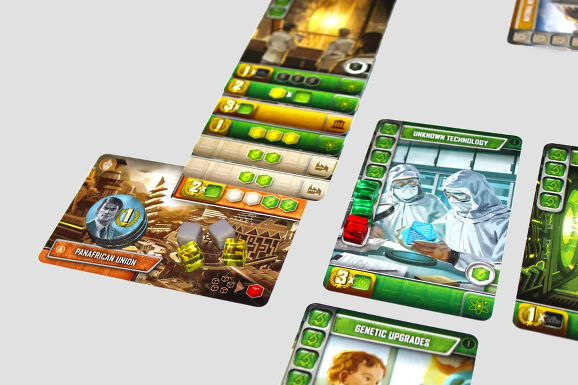
As soon as a card is fully resourced, it is added to your tableau, perhaps to produce cubes straight away if it makes a resource not yet produced this round. With careful planning cards can be daisy-chained in clever ways, especially in later rounds of the game. The last round of the game is especially brain-burning: I make 10 of this, and 8 of that; 3 go here, which completes that card; now I make 9, so I can place 1 more there to complete that...
The rub, of course, is getting the right cards into your hand at the right time. The large deck of cards in the game includes many duplicates so the distribution of the essential building blocks everyone needs is typically fair. But careful drafting is essential. The pull between taking something necessary but common, versus taking something rare but expensive to build is often tantalizing. If I pass on that Recycling Plant will I see it again? Also, after all players have chosen a card, they reveal their choices tipping each other to their plans for the rest of the draft. ‘Hate drafting’ a card you don’t want to build, but your neighbour likely does is made more attractive by the fact that a card can be converted into a resource cube instead of being built.
There are other dimensions to the game such as a small but important bonus mechanism and some point multipliers, but like the production, building and drafting mechanics these merge into a smooth playing, streamlined whole.
As similar as It’s a Wonderful World is to Terraforming Mars, it differs from Mars in a many ways. It possesses no game board. Players are simply building their own tableaux. The game has a fixed clock. It’s played over exactly 21 turns. The futuristic power blocks you play do not have asymmetrical powers. In the learning game, they do, but the game plays better without them.
I loves me some Mars, but I also like streamlined game play, and I really like games that are fast to set up. Wonderful World isn’t as grand in scope as Mars, but it employs the same search for synergy and creates a similar journey of hegemonic growth.
March, 2022
Tile Laying

Some board games don't have boards. They have a stack of tiles that players assemble into a board. Players take turns choosing a tile, and laying a tile. Carcassonne is an early example of such a game. And it’s still one of the best.
Carcassonne is a well preserved medieval city in the south of France. The walls of the city have a pointy geometry, sections of which fit nicely running corner to corner on a 45mm square cardboard tile. Carcassonne tiles show all kinds of wall configurations.
Imagine one with a section of wall running diagonally across it. Half of the tile is inside the city and half is out. Inside the city walls tiny red clay roofs crowd. Outside the walls green fields stretch. Put four of these tiles together and you have a tiny citadel worth 8 points. However, some tiles depict larger sections of city, not just a corner. Surround them with a few corner tiles, side tiles and end tiles and you can make a much larger jagged citadel worth even more points!
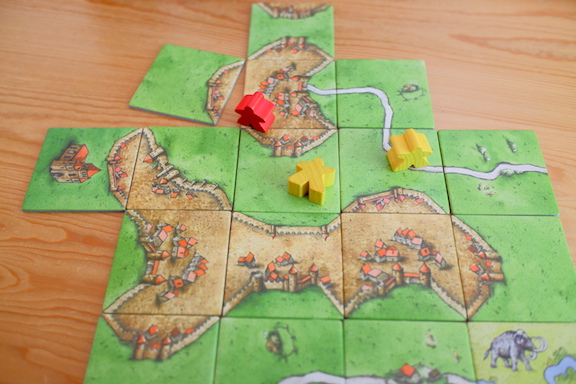
The only rule is that city must touch city, and field must touch field. Oh, and there are little roads on some tiles that run from a city gate, or through a field. Those have to line up too. And a tile must be laid next to one already on the table. And they're selected randomly. So, several rules. But not many.
As tiles are placed, a landscape gradually forms. It is dotted with little walled Carcassonnes. Meeples dot the landscape too. Meeples? Carcassonne introduced many to the jaunty little game piece that's used by so many games it's become an emblem for modern board gaming.
To earn the points offered by a city or road, players must claim it with one of their stout little wooden people. Players' meeples oversee growing citadels and lengthening roads with outstretched arms. Only when a city/road is completed (remember, they grow only one tile at a time) is the construction scored. This can take several turns. Players draw one tile each turn. Sometimes the tile needed to complete a complex city shape never appears.
There are many other nuances to managing your meeples, and blocking other players' constructions, scoring points based on the green space between the cities and roads popping up everywhere, even horning in on another player’s city, road or field. But those tactics are for Carcassonne sharks.
This game can be played at any level. It is friendly to all ages and skill levels. At its most basic it's a pleasant puzzle. "Where can I fit the piece I just drew?" When playing with my partner it's a cruel war between fortified hilltop towns. "Where will this tile get me points AND block Jeff from scoring that huge city he’s been building all game? If I put it here, he'll need to draw one of the rare saddle-shaped city pieces, and by my count there's only one left to draw. Mwwhahaha."
Although I’ve discussed the original Carcassonne here, we prefer to play Carcassonne: Hunters and Gatherers. It's the same game set in the Palaeolithic French landscape that adds a few bells and whistles to the game. There are a bizillion expansions for the original game, but we really like the balance that comes straight out of the box with H&G.
Walled cities built in the Stone Age? Not quite. In H&G, players build clumps of forest instead of cities, and rivers instead of roads. And the fields between the forests become wild meadows filled with the odd woolly mammoth and aurochs for extra points.
Whatever version appeals to you, Carcassonne is one of the original gangsters of board gaming. Just like that other OG, The Settlers of Catan, it’s a classic that must be tried. Some people say that Catan has been superseded by better game designs. Carcassonne, in my opinion, has aged better.
August, 2023
Tile Laying, with Animals!

Once in a blue moon, if you’re lucky, you get to witness the birth of a star. It can happen to astronomers and music fans and board gamers.
In 1990, I passed on an opportunity to see a new band from Seattle playing at a bar in Vancouver. Oops. A year later they released Nevermind, an album that defined a decade, revitalized rock, and introduced the world to the sound of the Pacific Northwest.
In 2020, I demo’d an unreleased tile laying game from a Seattle-based game design co-op. It rocked, and two years later, it won Spiel des Jahres. Ya lose some, ya win some. This is the story of the win.


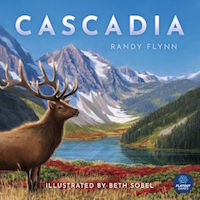
This is some invisible nonsense text that is hidden behind an image. It exists to provide a place to position and anchor link properly to allow the menu at the top of the page to jump correctly to the start of the next review. It exists to provide a place to position and anchor link properly to allow the menu at the top of the page to jump correctly to the start of the next review.This is some invisible nonsense text that is hidden behind an image. This is some invisible nonsense text that is hidden behind an image. It exists to provide a place to position and anchor link properly to allow the menu at the top of the page to jump correctly to the start of the next review.
In the fall of 2020, the Covid-19 pandemic was in full swing. Full bloom? Full lockdown. Our favourite board game convention, SHUX, had been postponed. Bummer. Sharon and I had been to two SHUXes, the only conventions we’d ever attended, and they were great. Board gaming conventions are a topic for another day, but suffice it to say: they’re super fun. We didn’t think we were con people. Thanks to SHUX we were.
SHUX is an annual convention organized in Vancouver, B.C. by the British board game gang Shut Up and Sit Down. The first SHUX was held in 2017, hosted entirely inside a downtown hotel. It was small (I think 700 tickets were sold) but it was a huge success. The second SHUX moved into the Vancouver Convention Centre and more than doubled in size. SHUX19 grew a bit in size again.
Sadly, the fouth SHUX, SHUX20, was not to be. Like large and small events all around the world, it was postponed in the interest of public health. Ever the innovators, SU&SD put together a virtual con. They called it AwSHUX.
AwSHUX successfully simulated a full blown gaming convention. For three days, there were video presentations galore on the show’s website. Most of these were live, a continuous 10+ hours of content. Video streams were patched together from God knows how many sources, using God knows how many software tools. A real, real-time, technical feat.
Exhibitors also displayed their wares on the AwSHUX site, and they demonstrated their games via chat. Several tabletop simulators had been developed in recent years and were put into service for AwSHUX. SU&SD arranged guest passes for Tabletop Simulator and Tabletopia for the duration of the con for all attendees. Did I mention, the whole event was free?
Sharon and I are friendly with computers. We met working tech support at an Internet company. We still use computers every day. But we do not enjoy table topping virtually. No better example of an oxymoron exists.
One of the reasons we play board games is because we love picking up game pieces and moving them around. Attempting to select a simulated game token with a mouse click, and then drag it to the edge of the computer screen, wait for the screen to scroll, drop it into your player area, rotate it with CTRL-R, then zoom out with another key combo to see the whole game state again... so painful.
Regardless, we tried a few virtual game demos at AwSHUX. We joined a chatroom that was gathering players for a new game being developed by a design co-op in Seattle. It looked like our cup of tea. It was a complex puzzle that proceeded along two different scoring axes: terrain type and animal grouping.
Players took turns choosing a terrain tile and animal token pair from an offering of four such pairs. They then added the tile to their landscape, matching terrains if possible, and placed the token onto one of their tiles sporting that animal’s symbol, building formations of animals, if possible, as suggested by a number of scoring cards. Lots of decisions. Few rules. Just the kind of game we enjoy.
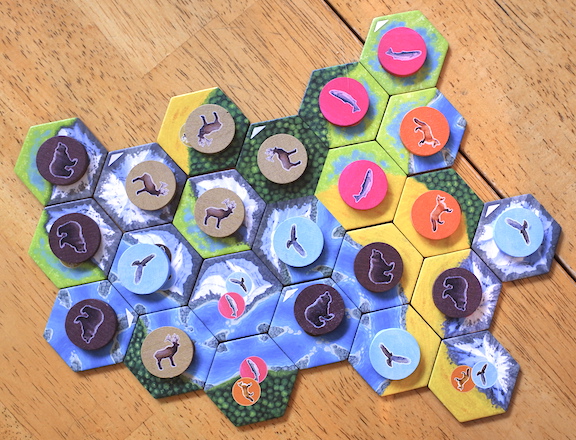
We learned how to play the game watching tiles and tokens float across our computer screen while we listened to the others in the chat introduce themselves and ask questions. The audio chat was provided by Discord, hundreds of channels set up by game publishers for the con. Chatting this way was fun in that awkward, walkie-talkie kind of way, trying not to talk over each other, but inevitably doing just that.
I don’t remember who we played that particular game with, but over the course of three AwSHUXs (#2 was held in the April of 2021, and #3 in October ’21) we played games with people from Los Angeles, Atlanta, Detroit, Calgary, Berlin, Mexico City, and São Paulo among other places. So cool. SU&SD and AwSHUX really helped us get through the pandemic, and I imagine many others too.
The game was great. Elegant, challenging, replayable, beautiful. The theme captured our imagination too, just as a good theme should. The game was soon to be on Kickstarter. We gave our feedback/raves to the person who’d demo’d the game and promised to kickstart it.
As everyone signed out of the chat, I asked the name of the demo’er in order to thank him properly for the good time we’d had. He’d been friendly and kind, like all the folks we’d met over the years at SHUX. He was soft-spoken and, as you’d expect, a good teacher.
“Randy,” he replied.
“You’re the designer of the game?” I asked incredulously.
“Yes,” he said, “I’m really excited about getting this game out there.”
The game was Cascadia. When the physical game arrived in our mailbox ten months later, it played even better in person than it had on the computer. Of course it did. There was cardboard to fiddle with. Tiles to rotate between thumb and finger while our brains parsed an optimum alignment. There were chunky wooden tokens that rattled in a cloth bag and suffered endless fondling while we tried to pull a bear. When we’d pass the bag to start the next turn, the active player would stick their hand into it and start singing, “No foxes. No foxes,” to a funky beat.
The only criticism that can be made of Cascadia is that it’s a bit ‘heads-down’. Players assemble their own little corners of Cascadia independently, so the only player interaction in the game lies in choosing a tile/token that someone else might really want. However, the points awarded at the end of the game for the largest area made of each terrain type encourage players to keep tabs on each other’s growing maps. Likewise, the competition for animal tokens. Their numbers can run out if everyone is trying to specialize in the same species. Most importantly, the intense puzzle of the game is so engaging, that one hardly notices this small shortcoming —one that, by the way, often plagues Eurogames.
Cascadia has been in high rotation on our game table ever since it arrived. We were chuffed when it won Game of the Year. We live in Cascadia, the bioregion comprised of British Columbia, Washington, Oregon and Idaho. We have black bears and elk in our yard from time to time. But our real affinity for the game is its gameplay. Randy Flynn has created a new classic of board gaming. And we were there to see it happen!
August, 2023
Games Should Be Fun.
Can They Be Important Too?

I’ve written a bunch about the pedagogical pleasures of board games. The way games can introduce us to topics, slyly educate us about them, and impart deep knowledge through the experience of play. Fun comes first, of course; we wouldn’t be playing a game if it weren’t enjoyable. But a good game, in my opinion, is a sugar coated pill. If a game isn’t teaching us something as we play, it’s leaving money on the table, because so many good games have demonstrated that games can teach while they entertain.
Pandemic [reviewed above] for example, teaches us global geography and the names of the world’s large cities. It also teaches us about the difficult decisions that must be made when fighting a relentless foe with limited resources. Ticket to Ride [above] teaches us about patience and flexibility as we assemble sets of cards to build rail links, and re-purpose cards when forced to reroute our rail network. The Quest for El Dorado [above] teaches us compromise. Use too many turns building a perfect deck of cards and you won’t have time to use them. De Vulgari Eloquentia [above] teaches us about medieval Italy in fine detail: scribes, the notes they scribbled in the margins of manuscripts, the abbeys where they worked, their political prospects as they moved up in the Church. Daybreak teaches us about alacrity.
Daybreak is an ambitious game. It tackles the most pressing topic of our times, climate change. It educates in many gentle ways. It successfully models the inputs of climate change using asymmetrical player boards. The game set-up introduces people to the actual current emissions, and sources of emissions, of different countries/groups of countries. It also models the effects of climate change using a deck of crisis cards. And it models many of the solutions to climate change using a deck of project cards.
Next, the game demonstrates the actual mechanics of climate change by using a game board that tracks global emissions, average global temperature, and ecological health. Every round, emissions cubes pile-up, tree and ocean pieces placed on the game board remove some cubes, the remaining ones drive up temperature bands on the world thermometer. More temperature bands result in more crisis cards and more rolls of a die that risks degrading the ecosystem. The feedback loops of the climate crisis are made plain.
Each card in the game is educational. First, they introduce topics that might be unfamiliar to players. Second, they provide detailed information about their topics - scanning the QR code on each card with your phone will take you to a page of information about how the card plays and the topic it addresses. Third, the large number of cards in the game reminds us just how many crises we face if we leave climate change unchecked, and just how many solutions to these problems already exist.
Daybreak contains all this detail but, thanks to the power of board games, it doesn’t overwhelm. The detail is embedded in the game, and the game play of Daybreak is smooth, engaging and fun.

At first glance, the game appears to be a simple engine builder like so many other games. The main mechanic in the game is activating cards in your tableau to perform their actions, and playing cards from your hand to your tableau to provide new actions. Cards have tags that are stacked as prerequisites for actions. Some cards can be used once per turn. Some more than once with sufficient tags. Some are used by expending another card from your hand.
Play is also simultaneous. Players plan how to use their cards at the same time. Some actions allow players to give cards to each other. Discussion is encouraged. Did I mention Daybreak is a cooperative game? Players win together by reducing emissions, or they lose together by being overwhelmed by crises.
This is a fun and fertile system. It offers many tough decisions because you typically start a round with only five cards. Play a card with a weak action you can use now? Or invest in a more powerful card despite not having enough tags to use it this turn? You only have five columns into which you may play cards. Putting a new action into play covers one of your existing actions. Which to lose? An important action of yours needs discards to activate; which cards do you burn instead of play?
As good as all this is, one tiny rule elevates Daybreak above similar games: you may play as many cards on your turn as you want. This creates a fluid play space which encourages out-of-the-box thinking and prioritizes flexible tactics.
The math of the game, the rate at which emission cubes pile up and crises multiply, is a vicious puzzle. Daybreak will trounce you repeatedly when you first play it. As experienced as my partner and I are at playing meaty Eurogames, Daybreak almost broke us. Game after game we asked ourselves, Why can’t we beat this game? We tried many different strategies, until we learned the secret of the game and started winning.
This is the final educational moment of Daybreak. To learn by doing is so powerful. This is the gift of board games. The way Daybreak uses a game mechanic to embody the lessons of activism is a triumph. I will say no more about these lessons so that you may enjoy discovering them yourselves.


View from our deck. Left: July 28, 2024 while we played Daybreak. Smoke from a wildfire 45km away creates a thick haze. Right: August 7. Less smoke.
The designers of Daybreak, Matteo Menapace and Matt Leacock, have created a truly important game. Never has the theme of cooperation been more apt.* We can only address the problem of climate change by ALL pulling together. It’s just that big. This is why government leadership to unify our response to the crisis is necessary. And why big business must either get onside, or be regulated into doing so.**
Daybreak won the prestigious Kennerspiel des Jahres (Connoisseur Game the Year) award for 2024. The KdJ is awarded to games that are more complex than those considered for the Spiel des Jahres. The SdJ highlights family friendly games. KdJ focuses on enthusiast games. Both awards are selected by the Spiel des Jahres jury, a group of 12 German game critics. I hope the award leads more people to play Daybreak. It’s super fun to play, especially once you start winning a few games.
* And that’s saying something, because Leacock also designed the cooperative masterpiece Pandemic.
** Such unity has been sadly lacking in Canada due to regional interests which have allowed oil companies to continue to increase production even as those regions burn. Every time I write about climate change, there is a new disaster to discuss. A few weeks ago, one third of the famous tourist town of Jasper, Alberta burned to the ground. Climate change has increased the number of forest fires around the world, and their ferocity. Hotter average temperatures create drier forests. If fire strikes, it spreads faster across the land than in the past. Evacuations stress communities. Rebuilding stresses families even more, because the insurance industry is overwhelmed. For some reason, the increased costs of these predictable fires are not being considered as we continue to rely on fossil fuels and allow the oil industry to produce and export ever greater amounts of their toxic products. This is a false economy. A dangerous economy. An economy that lines the pockets of some, at the expense of many, many more. The whole planet in fact. (If you think that was a rant, read my real thoughts on climate change.)
August, 2024
One Game to Rule Them All
And to the Table Bind Them
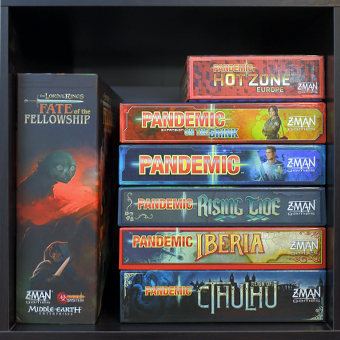
I don’t usually review a game immediately upon its release. We typically add games to the collection after they’ve proven themselves and bubbled up to the top of many people’s recommend lists. But this wasn’t the case with The Lord of the Rings: Fate of the Fellowship because it is built on the Pandemic engine, a tried and true game system that we love.
The Pandemic System powers many games. It originated, as one might expect, with the timeless co-operative game Pandemic [reviewed above]. But game designers quickly realized that this tiny machine of cards and cubes and nodes on a map could tell many stories, not just the story of viruses and vaccines. The Pandemic engine has also been used to model (among many other themes) flooding in the Netherlands, barbarian invasions of ancient Rome, and climate disasters in Canada. OK, that last one isn’t an official release by Z-Man Games, the publisher of Pandemic titles; it’s a version by yours truly called Crisis Borealis that you can find here.
Here's a list of Pandemic System games. Titles with an asterisk are ones I have not played and so can’t recommend, although I’m sure they’re great too because, Pandemic.
- Pandemic, 2008
- Pandemic Legacy: Season 1, 2015
- Pandemic: Reign of Cthulhu, 2016
- Pandemic: Iberia, 2016
- Pandemic Legacy: Season 2, 2017
- Pandemic: Rising Tide, 2017
- Pandemic: Fall of Rome, 2018 *
- Pandemic: Hot Zone - North America, 2020
- Pandemic Legacy: Season 0, 2020
- Pandemic: Hot Zone - Europe, 2021
- World of Warcraft: Wrath of the Lich King, 2021 *
- Crisis Borealis, 2022
- Star Wars: The Clone Wars, 2022 *
- The Lord of the Rings: Fate of the Fellowship, 2025
In my opinion, Pandemic Legacy: Season 1 is the greatest Pandemic. It offers a sequence of 12-16 games that create a grand narrative of evolving circumstance and evolving rules. (If you’ve played the game, you might be interested in the story that our play through created.) However, Pandemic Legacy is a specialized game that requires a significant commitment of time to fully enjoy.
[no pic of PL:S1 - spoilers]

For more casual gamers, I’d recommend Iberia, the version of Pandemic set in 19th century Spain and Portugal. It includes additions to the original game that elevate theme and gameplay beyond Pandemic and even beyond the excellent On the Brink expansion for Pandemic.
If you play Pandemic, get On the Brink. It seasons the original game like that last pinch of salt does to a dish.

Playing Pandemic with the On the Brink expansion. Purple cubes! Oops. No purple cubes are left to place: a loss by mutation.

Pandemic: Rising Tide is my third (or second, depending on how you count Legacy) favourite flavour of Pandemic. It transliterates the cube mechanic to represent flood waters. They now flow across regions of the game board. So lyrical. The maintenance loop of the game (keeping diseases/flood waters at bay) becomes even more critical. The pressure Pandemic creates is so great. Go left, or go right? Calculate rough probabilities. Treat or pursue cure? Rising Tide finely tunes these dilemmas.
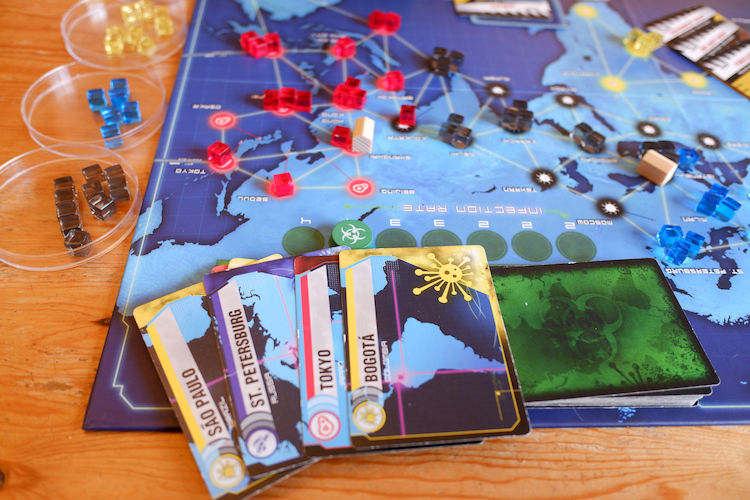
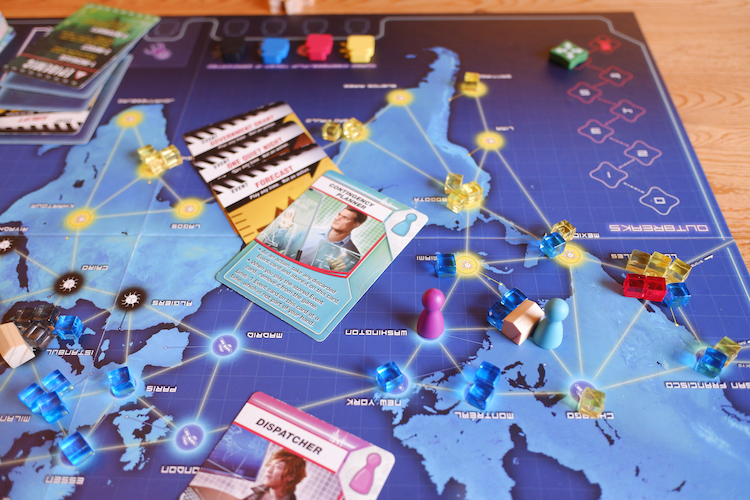
TANGENT: An unsung virtue of Pandemic is how readable its board is. It captures the game state so legibly. A photo of the board at the end of a game tells the story of that victory/loss in detail. For instance, here's a squeaker. You can tell we won the game because all four Cure markers are on the board, the Outbreak marker is just above the last space on its track, there are cubes left in the petrie dishes, and Player cards are left in the draw pile. You can see how narrow the win was, because of the few Player cards left (the next one to be drawn would have been our sixth Epidemic). You can tell that we just suffered an Epidemic because I fanned the Infection cards we drew... while the Outbreak marker was one space from death! Look closer and you can imagine how we held our breath as we flipped Infection cards because so many of the Cities in play already had three cubes. Because this photo is of the final game state, you can tell that Bogota and St. Petersburg must have been free of cubes before the draw (they didn't blow because some of their neighbouring cities don't have cubes). What luck. You can even dig further back in the game and see that Chicago suffered an Outbreak at some point, and Los Angeles, and Sydney twice! Milan too. Miami is infected with blue which likely came from Atlanta, although we can't rule out Washington. Someone, somewhere didn't wash their hands. But in the end, Quinn the Dispatcher and Sheldon the Contingency Planner (not our favourite role) got the job done. Sheldon played three Event cards twice. The last Event didn't enter play. Getting two Research Centres onto the board for free must have really helped us. Maybe we Forecast to avoid disaster on that final Epidemic. Sheldon, you earned your government paycheque this time.
Reign of Cthulhu strays a bit far from standard Pandemic mechanics. It adds all sorts of bells and whistles that, while they suit the game’s theme, mess with game balance a little too much for my taste. Still, lots of Pandemic-y goodness lurks in the game.

Reign of Cthulhu contains miniatures instead of pawns. The minis of the Old Ones that you see here are NOT included in the game. Those come from The Doom that Came to Atlantic City. They actually fit in the Reign box. When an Old One card flips, I place the matching mini on it for added terror and insanity.
We have not played Fall of Rome. Strange, I know, given my love for all things Italian and Roman and Pandemic. For some reason, when we saw the game demo’d at a game conference, it just didn’t appeal. Cubes spread along routes on the game board. Different colours trace the historical paths taken by different tribes, Vandals, Goths, Huns, etc. Players recruit Legionaries. Dice battles ensue. I think my prejudice against dice and battle calculations worked against trying the game. Luckily another Pandemic game was to come along that used dice.

So many cool Pandemic games. The Lord of the Rings: Fate of the Fellowship stands on the shoulders of all this variety and innovation.
The Pandemic engine now marches orcs across Middle Earth and moves Nazgûl in search of Frodo while players attempt to get Frodo and Sam to Mt. Doom to destroy the One Ring before they’re overwhelmed by Despair. Hope/Despair are tracked instead of Outbreaks. Objectives, new to the game, can restore Hope. Players assume two roles each, taking 4 actions per turn with one role and 1 action with the other, player’s choice. The Roles are based on 13 characters from The Lord of the Rings, each with several appropriately themed powers. It’s Pandemic turned up to eleven. And it’s good.
The story telling in Fate of the Fellowship is superb. Sure, this game has a leg up because it's based on a great work of literature, but there are many games that try to marry their mechanics to a famous tale and don’t achieve the sweep and immersion that this game does. It’s uncanny how the movement of pieces on the game board evokes the War of the Ring. Each turn feels like a chapter of a book. Players feel the force of difficult decisions, partings, reunions, triumphs and losses just like the heroes that they read about in the trilogy, and that they now play.
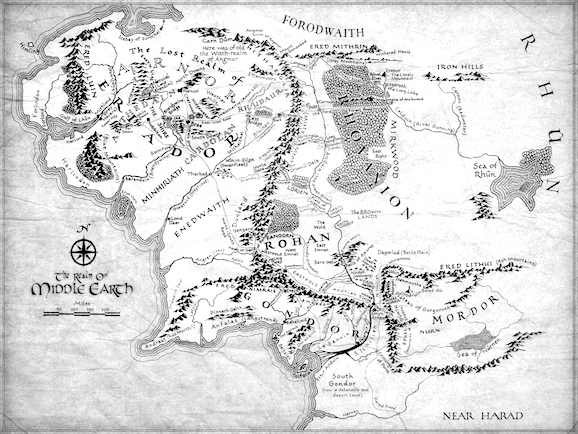
And the map. There is hardly a more famous one, at least for fans of fiction. If ever a map begged to be turned into a game board, it was this one. Perhaps this is what led this latest evolution of Pandemic, because Fate of the Fellowship, while driven by the basic dynamics of Pandemic, is also a dudes-on-a-map game.
Depending on the shuffle of the threat cards (called Shadow cards in this game), sections of the board will experience more incursions of evil than others. Areas will need to be controlled by the fightier roles while the hobbits slip south. Who knew I like racing into dice battles so much? Go Frodo! The way is clear. The Nazgûl have flown and the Eye of Sauron is elsewhere.
I don’t like dice. I don’t like calculating the odds of rolls, and shaping game decisions around them. Dice are tools of the Dark Lord.
But Fate of the Fellowship is making me more comfortable rolling battles, probably because the dice symbols that determine the outcome of battles are balanced slightly in favour of players, and there are copious ways to prepare to mitigate critical dice rolls. And because battle is necessary. It is thrust upon the Fellowship by the relentless advance of Sauron’s forces. Being a Pandemic vet, I know how important it is to get cubes off the board. So it is in war, whether we like it or not.
Fate of the Fellowship is that rare hybrid of Euro, Ameritrash and war game. It is a light war game to be sure, but that element of play is strong, which makes it a great introduction to the genre.

Spiders have come from Mirkwood to reinforce Moria!
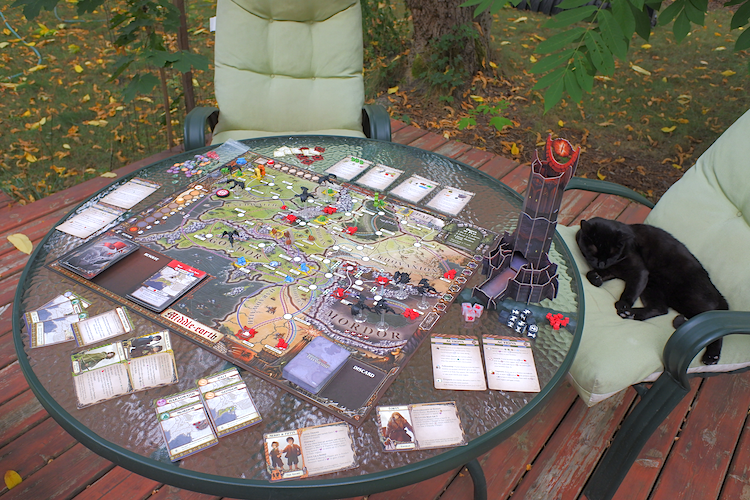
Sauron sleeps in Barad-dûr. (His name is actually Beans, not Sauron, but he does have a bratty streak.)
Perhaps it’s the pedigree of this game. Or its delicious, everything bagel mechanics. Its sumptuous art design. Or maybe just its fun dice tower, but Fate of the Fellowship is compelling. Another gem in the Pandemic firmament. A Silmaril that burns with the Light of Valinor.
September, 2025
The Play's the Thing

What makes a game a game?
In 2018, a curious game took the gaming world by storm. It was a simple game. A small box of 100 numbered cards. Two rules. Deal increasingly larger hands of cards to those playing. Play those cards to the table in ascending order.
Some people thought the game wasn’t a game. It seemed ruleless to them. They called it an activity. Faced with the task the game presented them they didn’t know where to start. I suspect the game made them uncomfortable, because there was actually one other rule to the game. No talking.
No talking!?!
How does the person holding the lowest card know they’re holding the lowest card so they can play it first? Well, they gotta figure it out somehow. And therein lies the game.
The game is called The Mind. It styles itself as a game powered by telepathy, but really it’s a game about body language. Although speaking is forbidden, other forms of communication emerge. Strictly speaking, no communication is allowed, but each group of players will arrive at their own level of stricture. In our plays we strive for pure telepathy, but when the going gets tough, we allow facial expressions, tentative gestures to play a card, and polite nods.
The game is played in rounds. In the first round each player gets one card. In a four player game, given a good shuffle, one player will have a low card, one a medium-low card, the third a medium-high card, and the last player a high card. Knowing that the cards run from 1 to 100, the player holding a card below 10 will feel safe playing their card first. A player with a card in the teens or twenties will feel a little less safe to start. However, not all shuffles are fair. It’s entirely possible that one player is dealt the 22 and another the 25. Or the 23. Yikes.
If a card is played out of order, the player holding a lower card puts up their hand and reveals the card or cards that should have been played. If other players also have cards that were eclipsed, the play them too. Then the team loses a life, and the round continues. Each game includes a number of lives. Winning certain rounds earns an extra life. Lose all your lives, and the game is lost.
As the rounds progress, more cards are dealt to players. For a four player game, 8 rounds are played, so in the final round, players each hold 8 cards. 32 of the 100 cards are in play. The gaps between numbers have narrowed, but so has the team’s rhythm.
This game is truly fun. The game exists in the space between players. It hovers above the game table. Everyone at the table is engaged every second of play. Players look each other in the eye in search of any clue about who should play a card next. Glances probe left and right, unless they don’t; someone may be sitting back in their chair because the only card they have left is number 100.

It is entirely possible to accomplish this seemingly impossible task, although some rounds will fail. We’re often surprised how we squeak through the bottlenecks the game presents such as when three of us slap down the 44, 45 and 46 in quick succession. Cheers and sighs of relief erupt.
To gamers who prefer the heads down experience of maxing their own player board / resources, this game is an abomination. Too intimate. But for others, it highlights that the play’s the thing, not the number of components or thickness of rulebook. The other players at the table are what make a game.
resource: The English version of The Mind removed the playful subtitles from each Level card. Here are the Level cards with English translations of the German subtitles. A set-up card is also included.
about the photo: the card spread above shows a round of The Mind we played in Vancouver at SHUX18. It was late on day 2, after 10 p.m. and we'd just met Angie and Jack. I'd packed The Mind to the con and carried it around for just such an occasion. I can't remember if we were introducing the game to Angie and Jack or not, but I do remember we won! What an extraordinary experience. Did I mention we'd just met? After the game, they asked if we liked trick-taking games and recommended we try The Fox in the Forest. Some time later, we did. (See next review!)
September, 2025

Strategy
vs.

Tactics
I suck at strategy. Twilight Imperium is such a headache for me.* Choose an alien race. Study it during set-up. Study the game board. Count planet symbols. Study the other races in play. Bid for home world placement. Choose a corner of the universe and neighbours. Even before conquering a few nearby planets and making some plastic, even before seeing the initial point goals revealed, even before my first turn in the game, TI requires a game plan.
Different races require different strategies to win. The game follows a single (long) sweep. Expand. Build. Battle. Re-build. Grow. Grow. Grow.
Grow in capabilities with tech, tech suited to your race. Grow in strength. Build your capital ship. Build war suns. Bulk up on action cards to protect yourself against other players’ action cards.
Time your growth to be strong enough to grab points. Then be strong enough to make a run at the final winning points. Carefully position yourself relative to turn order to grab the Speaker token and then the Imperial strategy card. Plans within plans. Wheels within wheels.
TI is operatic in theme but also in play. It is an intricate dance with the game’s mechanics and with your competitors. Like a musician interpreting a musical phrase, a player sculpts a shape of game states. A shape that goes right back to the beginning of the game. A shape streamlined by the unique features of your space race —if you can grok it, navigate the worm-holes in the game (those damned action cards), and hold the centre.
Conquering the galaxy is a specialized skill. I always get overwhelmed and out played.
Tactics, on the other hand, I love. Deke, dodge, pivot, adapt. I do well in games with simple rules, many turns, and lots of tiny decisions that move you toward victory (not one or two big plays or pulls of the trigger). My partner does too. She’s particularly fond of trick-taking games, an almost purely tactical genre of gaming. Both of us whiled away many lunch hours in high school playing Euchre in the cafeteria. She more than I. I never skipped class to continue playing, however. She and her best friend often did.
The Fox in the Forest is a two player trick-taking game. Like most card games it packs a lot into a small box. It uses a custom deck of cards which come in three suits of 11 cards each. The odd numbered cards are illustrated and have different, clever, trick-breaking powers. The 1’s, for instance, retain the lead. The 11’s force your opponent to play their highest card of that suit, or play the 1. The 3’s are foxy; they let you change the trump suit.
Points are awarded for each hand according to the number of tricks taken. Each hand consists of 13 tricks. Take 7 to 9 tricks to be victorious — six points. Take more than 9 and you’re greedy — no points. Take 1 to 3 tricks to be humble — a smug six points.
There is no ‘shooting the moon’ like in Hearts or Euchre. Players look at their starting hand and curse it if it’s too strong. How am I going to lose 4 tricks with THIS mess? That little Fox might help. Or maybe the Woodcutter (the 5’s), they let you draw a new card then discard one face down from your hand. Please let me draw something low!
Most hands, of course, are middling and you don’t know until after a few tricks have been played if you should strive for victory or humility. Seven cards are left undealt each hand so you don’t have complete information about the other player’s hand. Depending on the delicious vagaries of trick taking (being short suited, trump, holding or being stuck with the lead) a mixed hand can win. The last three or four tricks are always tense. Players have committed to a course of action and must hope their attack plan or deflections succeed. Does she have the 8? She does!
The game is styled with fairy tale characters which aren’t really my bag. But this hardly matters when the game play is as good as it is here. Games end after a hand in which a player earns their twenty-first point, so most games are made up of three or four hands. Just the right length of play for an after work filler.
My partner is often frustrated with my ability to outfox her in this game. During our ritual post-game consolation hug she vows she’ll never play Fox in the Forest with me again. I remind her there are plenty of games after which I rely on ‘the hug’ too. She concedes this, and admits that her love of trick-taking will entice her back into the forest sooner than later. The Fox in the Forest is just that good.
* This post isn't a review of TI. I am in no way qualified to review that game. I mention it as an example, THE example, of a strategic game.
September, 2025
Storytelling in Games
Games don’t really have plots. The narrative most of us are familiar with is linear, the kind you find in most novels, films and TV shows. This lets authors lead their audience up and down the hills and valleys of action through a series of climaxes to resolution. Games are special because they proceed according to the choices players make. Keeping these choices in a tight narrative lane is almost impossible for game designers, although some try.
Designers can shape the broad strokes of events in a game using structures like missions, levelling up player character abilities, timed events, etc. Some games even adopt scripts that players move through like those choose-your-own-adventure books of yore.
So I guess some games do successfully implement plot lines, although ones with internal contingencies and no guarantees that all events written by the designer will come to pass during play. Pandemic Legacy is a prime example of this (see our spoiler laden play through). The recent Earthborne Rangers too.
I admire these attempts at non-linear storytelling, but what I enjoy most in a game is emergent narrative: the story that a game generates via play, especially in a game that isn’t striving to tell a particular story but has such strong thematic elements that it’s easy to imagine a sequence of events unfolding with each turn. The race game The Quest for El Dorado [in the cupboard] does this. «Thank you Captain for taking us across that raging river. Look a Prop Plane! Start it up. We can see El Dorado in the distance! Thut-thut, thut-thut-thut, thut-thut-vroom.» Also, the meandering point salad extravaganza De Vulgari Eloquentia [in the cupboard].«I am but a poor Merchant, but I have travelled widely and studied the Canticle of the Sun and now wish to become a Monk. One day I will gain access to the Papal Library!»
My favourite games are ones that do this AND create a game board or tableau that can be read at the end of the game. The game CV [cupboard] does this effortlessly; see that review for a story resulting from play. Another game that makes stories is the card game Fugitive thanks to its chase mechanic and beautiful illustrations.
Fugitive is a two player, asymmetrical, deduction game based on the movie of the same name. It’s based on a deck of cards numbered 0-42, and a small dry-erase board. The Fugitive player controls the cards and plays a few of them at a time from their flexible but small hand, face down, to create an escape route for themselves. The Marshal tries to guess their location (the number of the last card they played) and tracks their guesses with the dry-erase board.
The Fugitive starts with the 1, 2, 3 and 42 in hand then draws three random cards from those numbered 4-14, and 2 cards from those numbered 15-28. This gives them eight cards to initially play. Cards must be played in ascending order. The 0 card starts on the table face up. If they manage to play the 42, they win the game. If the Marshal guesses the last card the Fugitive played, they win.
The problem for the Fugitive is that they can only play a card within a range of 3 of their current location unless they play other cards on that turn. Each additional card adds 1 or 2 to their sprint. This can get them out of a tight spot, but thins their hand substantially. At the end of their turn the Fugitive draws one card to replenish their hand. The Marshall also draws a card on their turn, which helps them eliminate places the Fugitive could be.
Feints are allowed; for example, the Fugitive may play 3 cards to create a possible jump of 7 implying they’re making a big run this turn, but choose to play a card only a few spots down the road, effectively ducking into an alley.
If the Marshal guesses a card that has been played, the Fugitive must reveal it. With a bit of arithmetic the values of the hops made by Fugitive become more certain, allowing the Marshal to better triangulate the Fugitive’s current location.

Fugitive is splendid cat and mouse. And it creates a splendid tableau at the end of the game, when regardless of who won, the players flip all the cards played by the Fugitive. The art on the cards are like stills from an action movie (duh) and they string together a little story of running and jumping, flight and pursuit.
October, 2025
Jeff Hohner, 2013-2025

